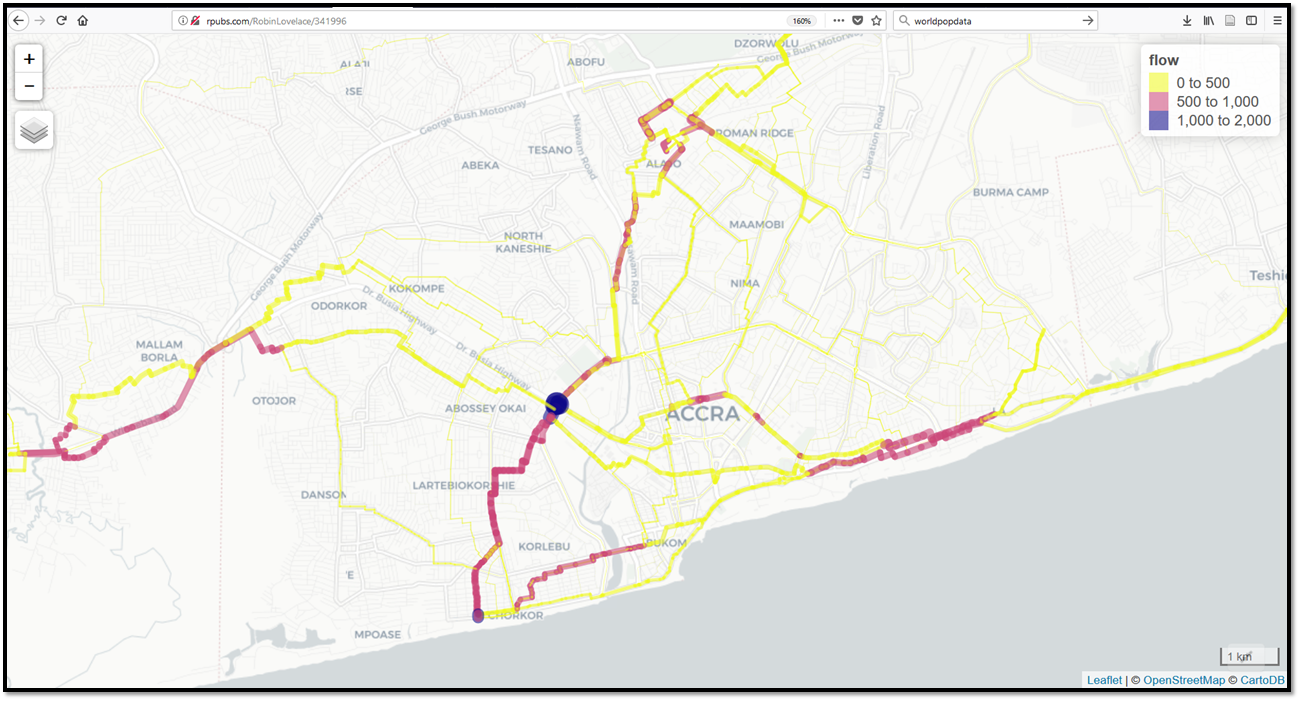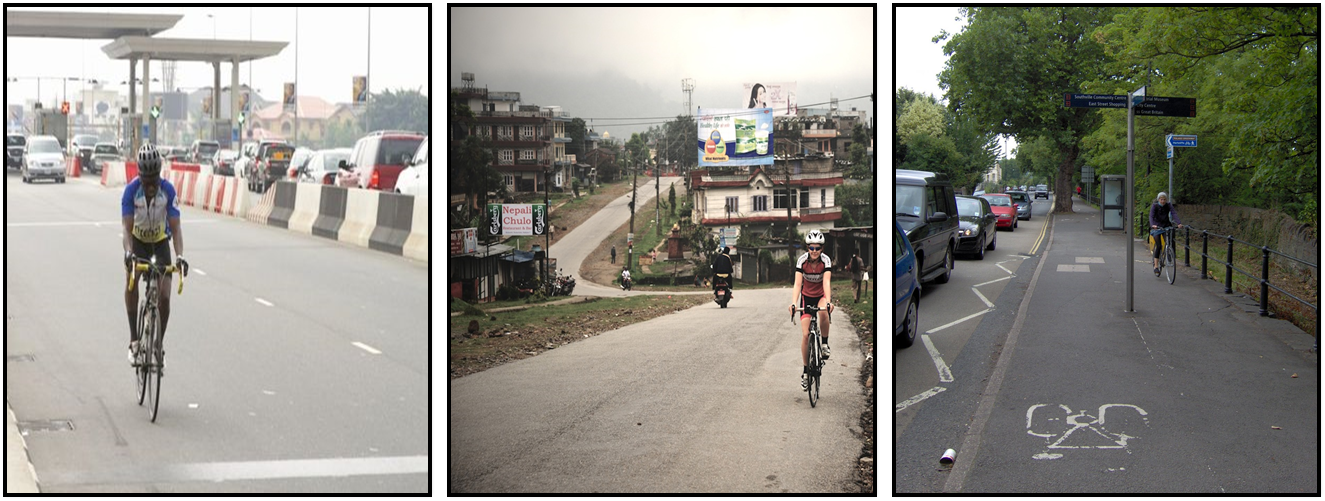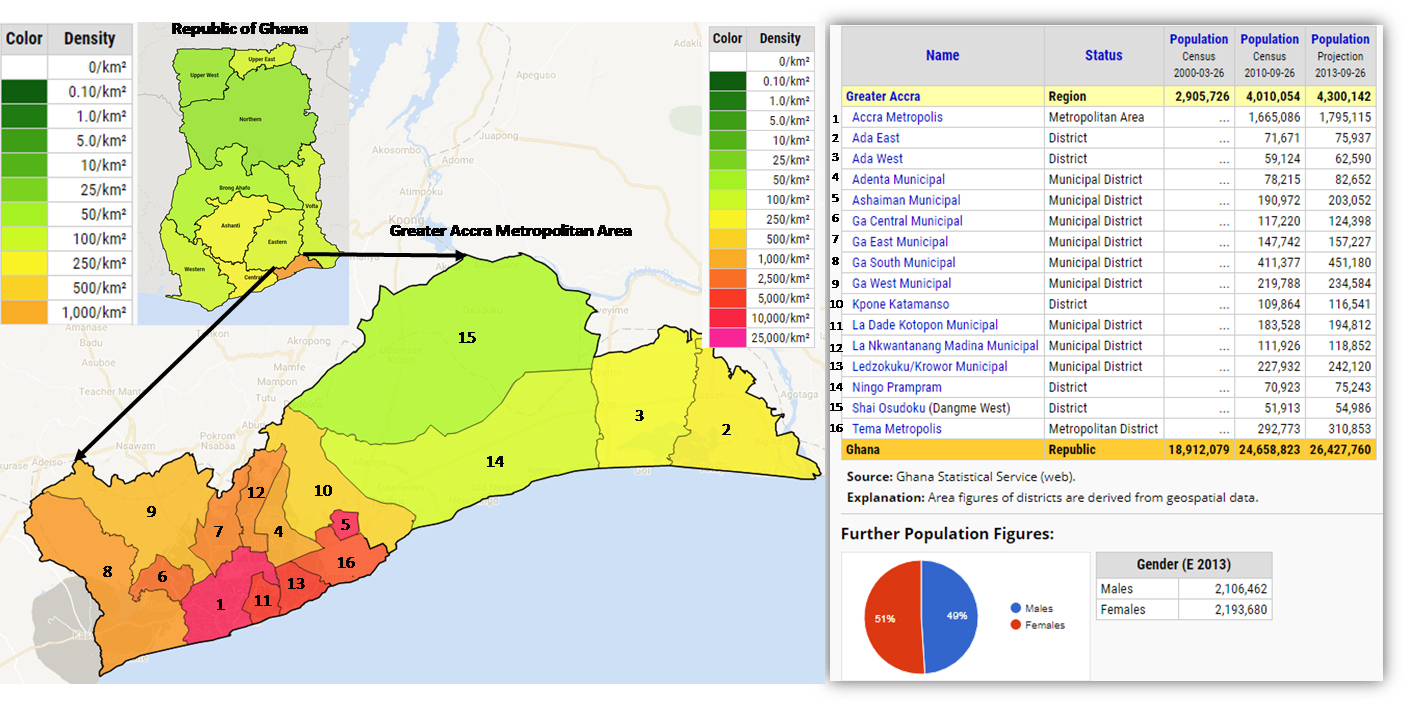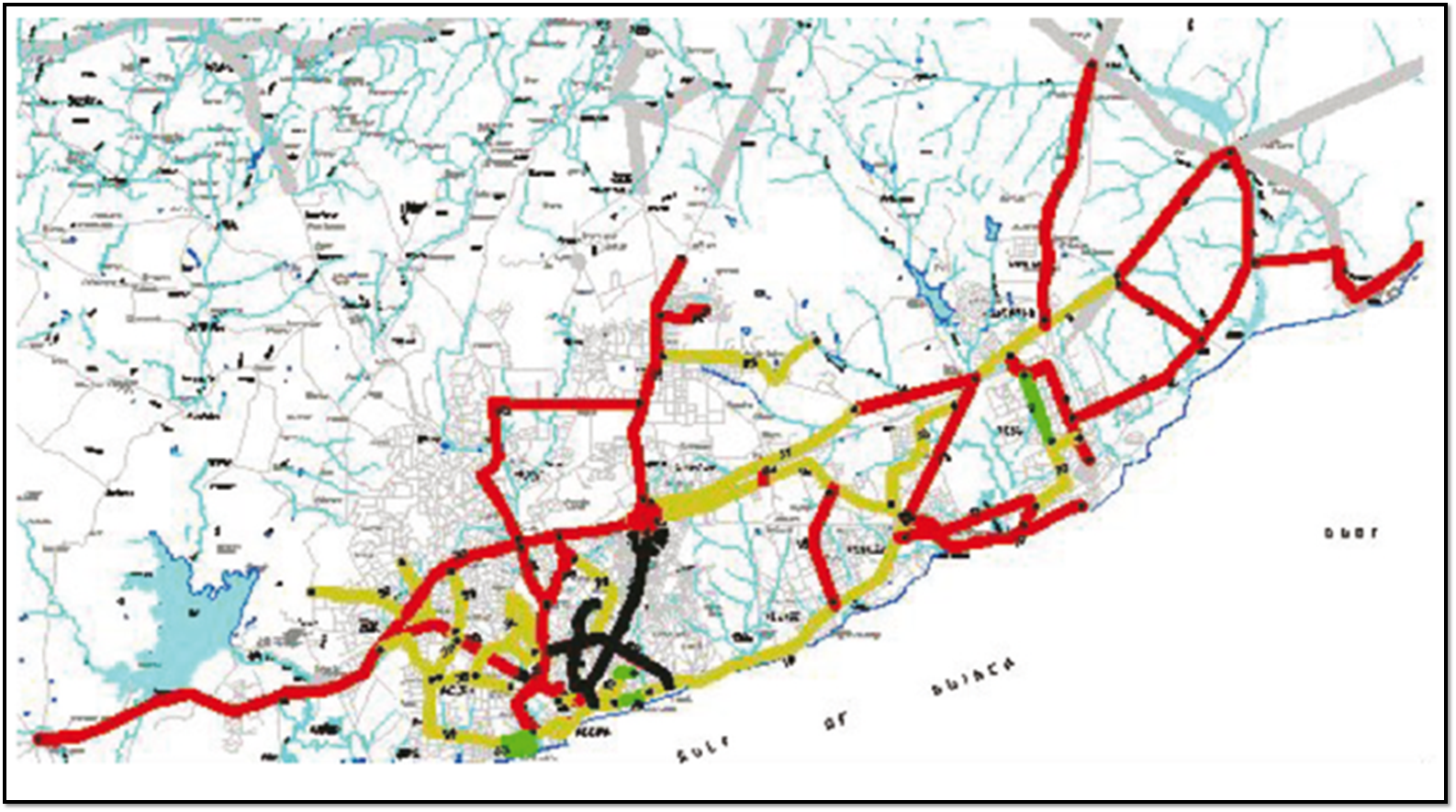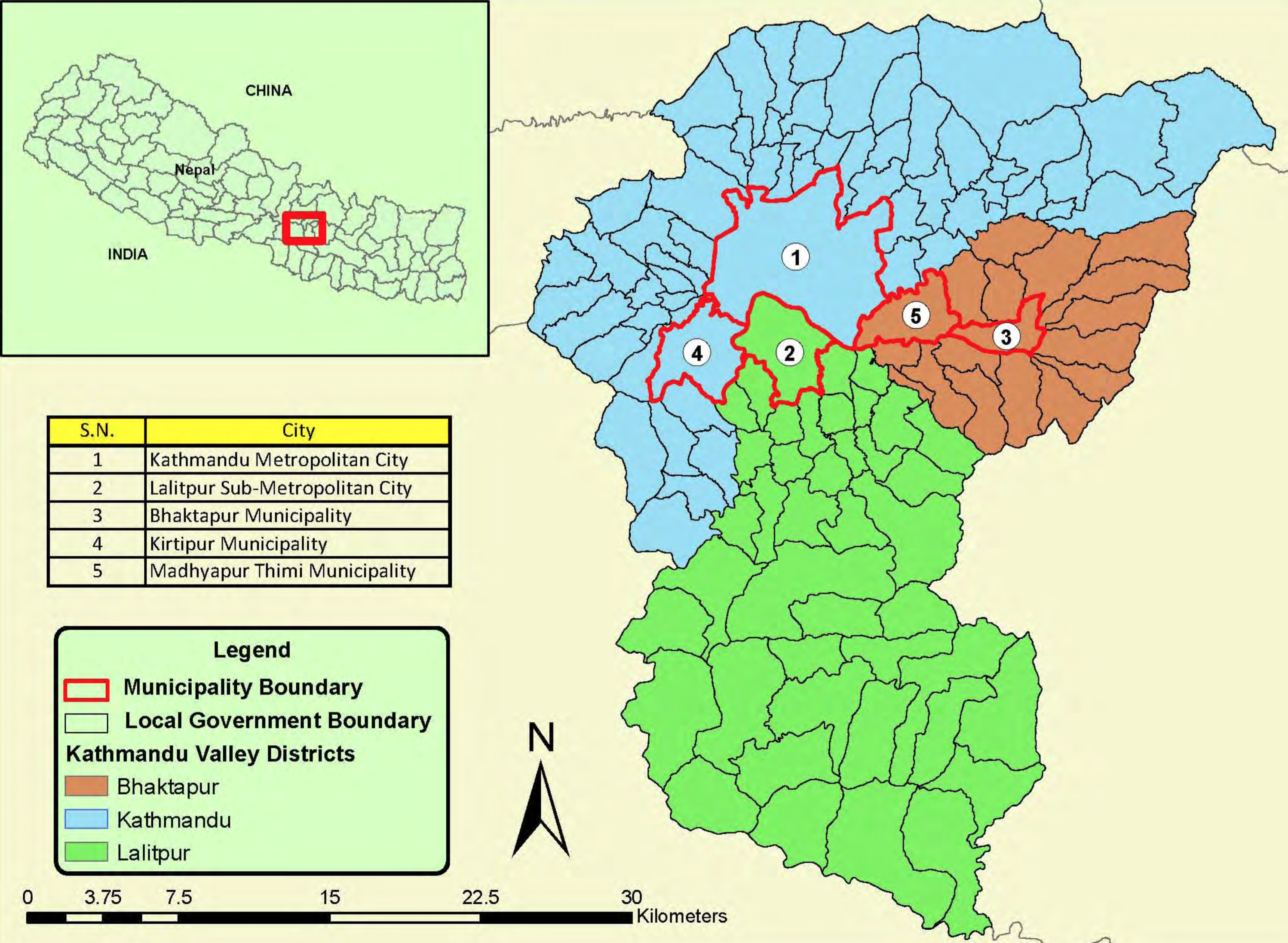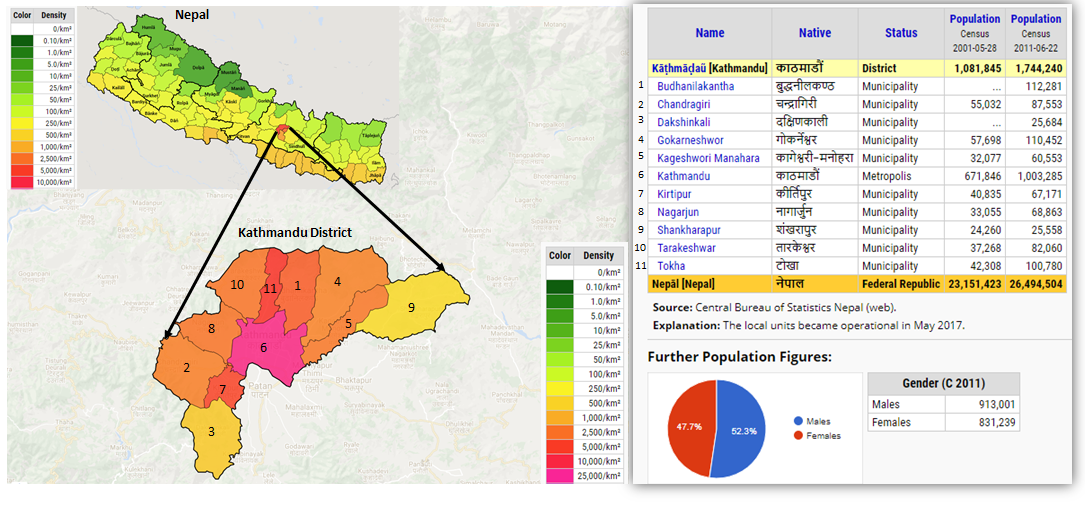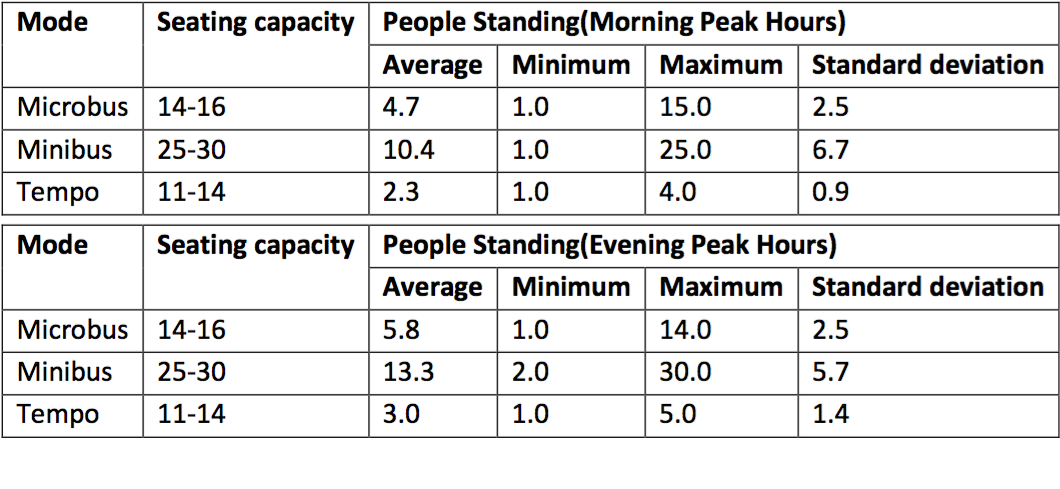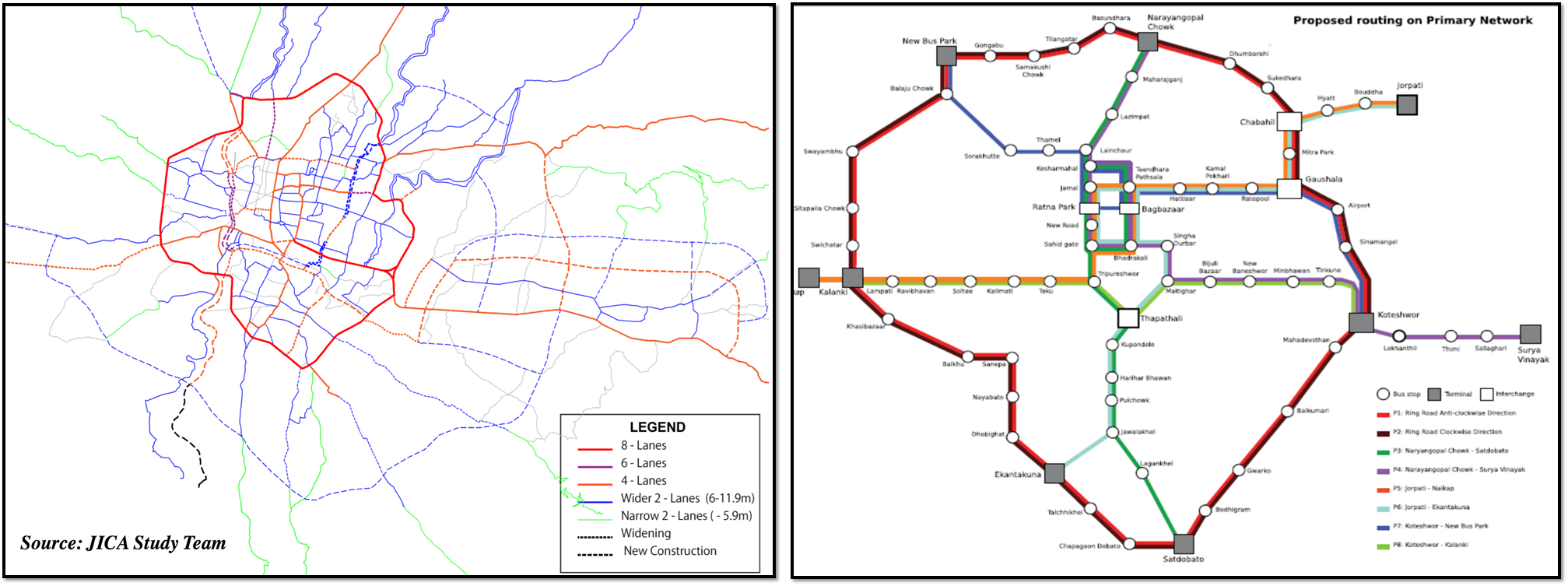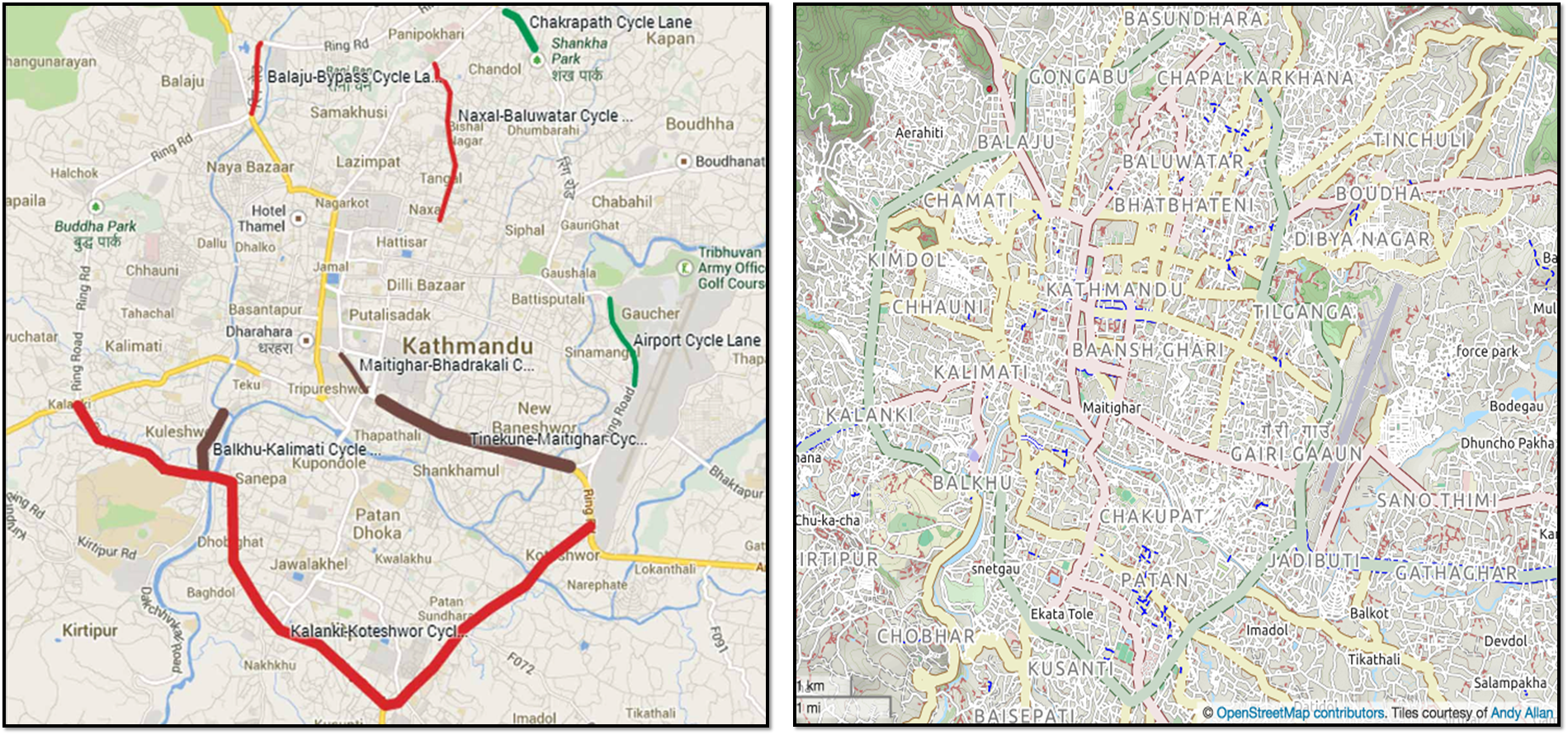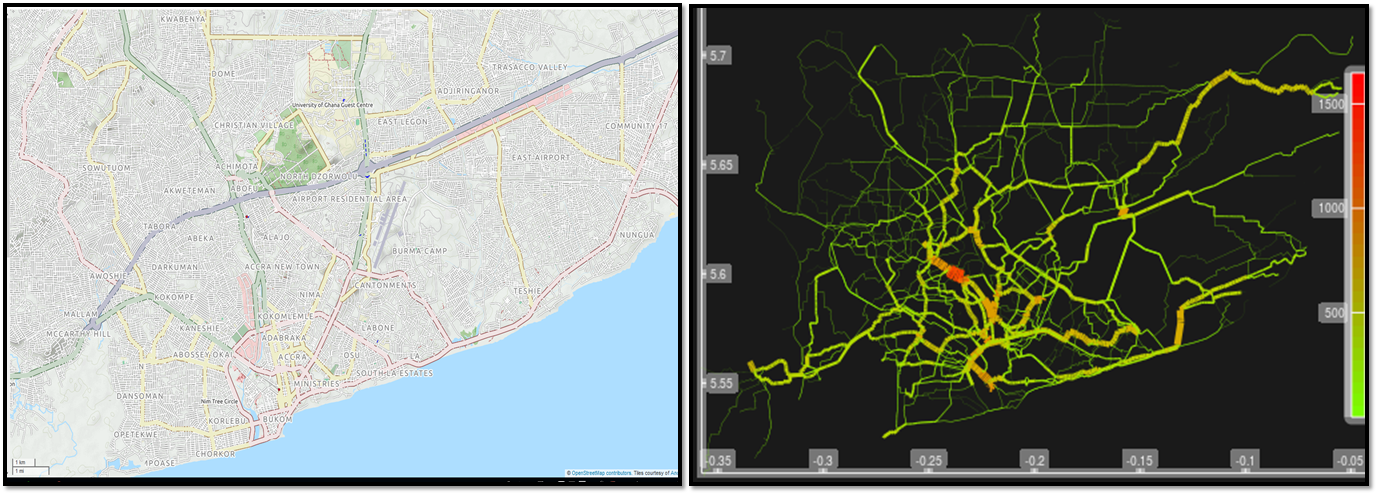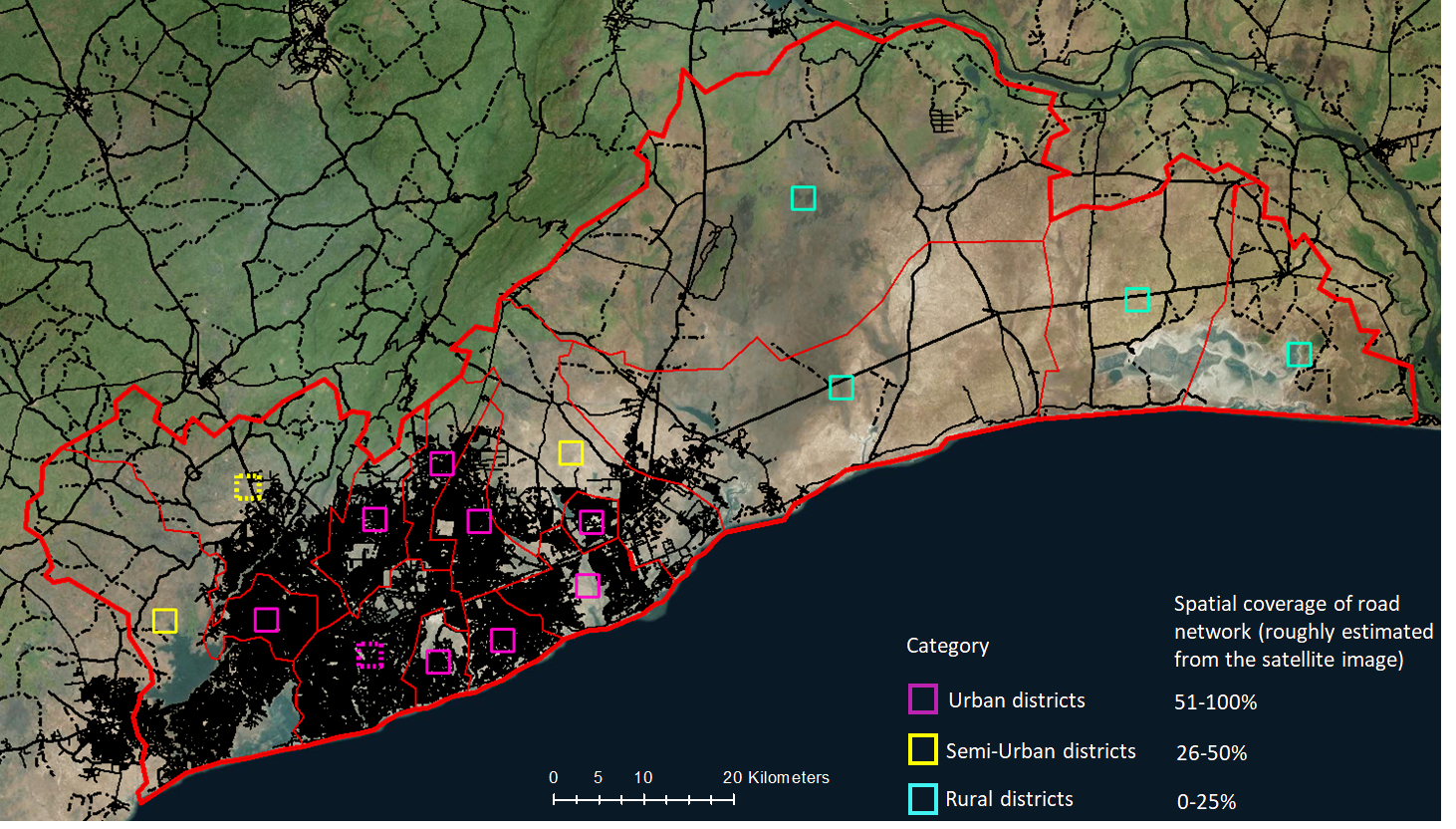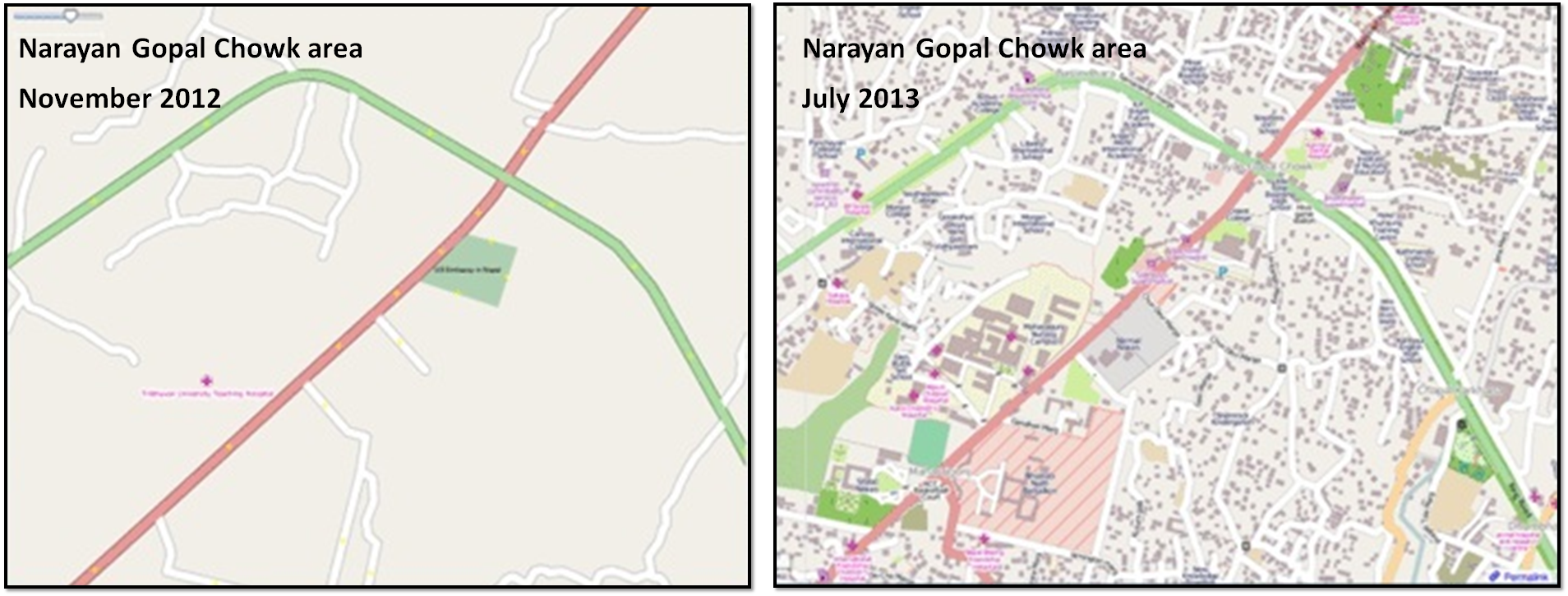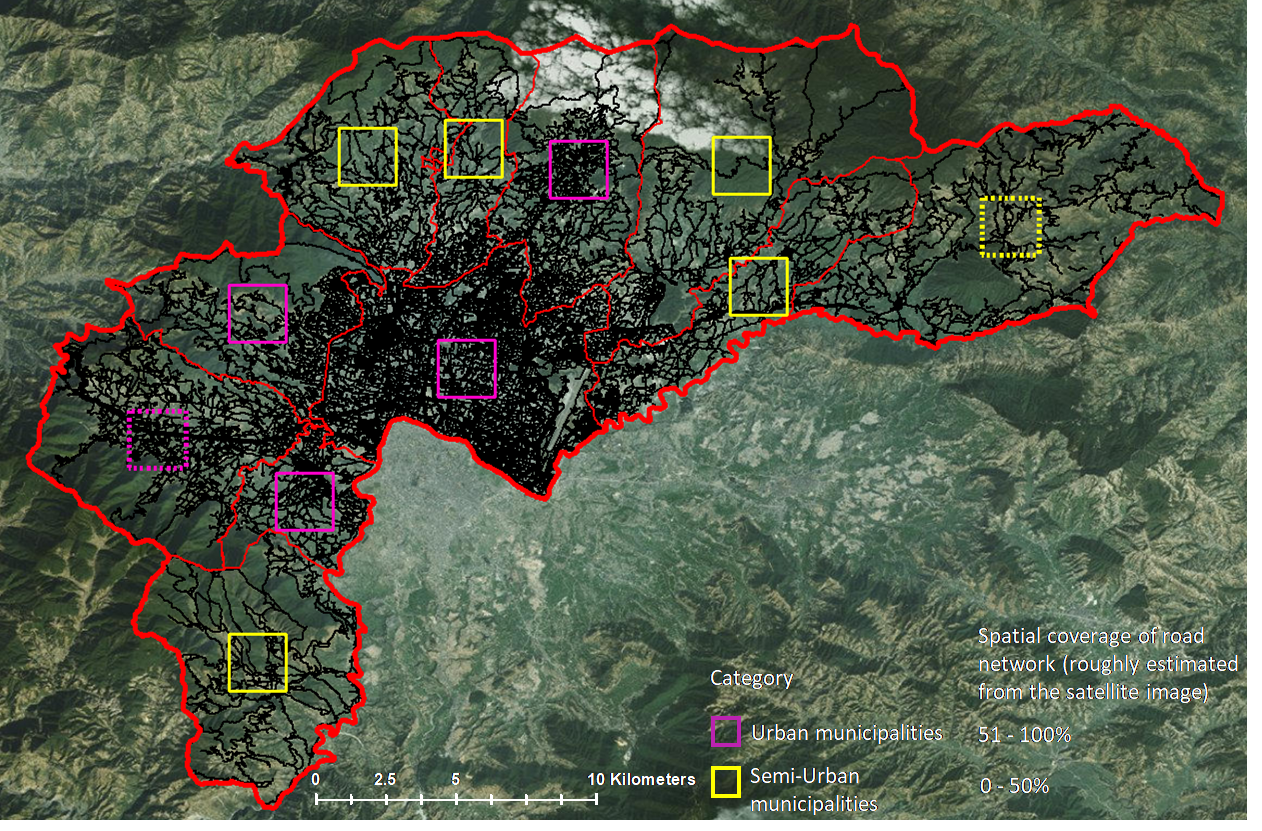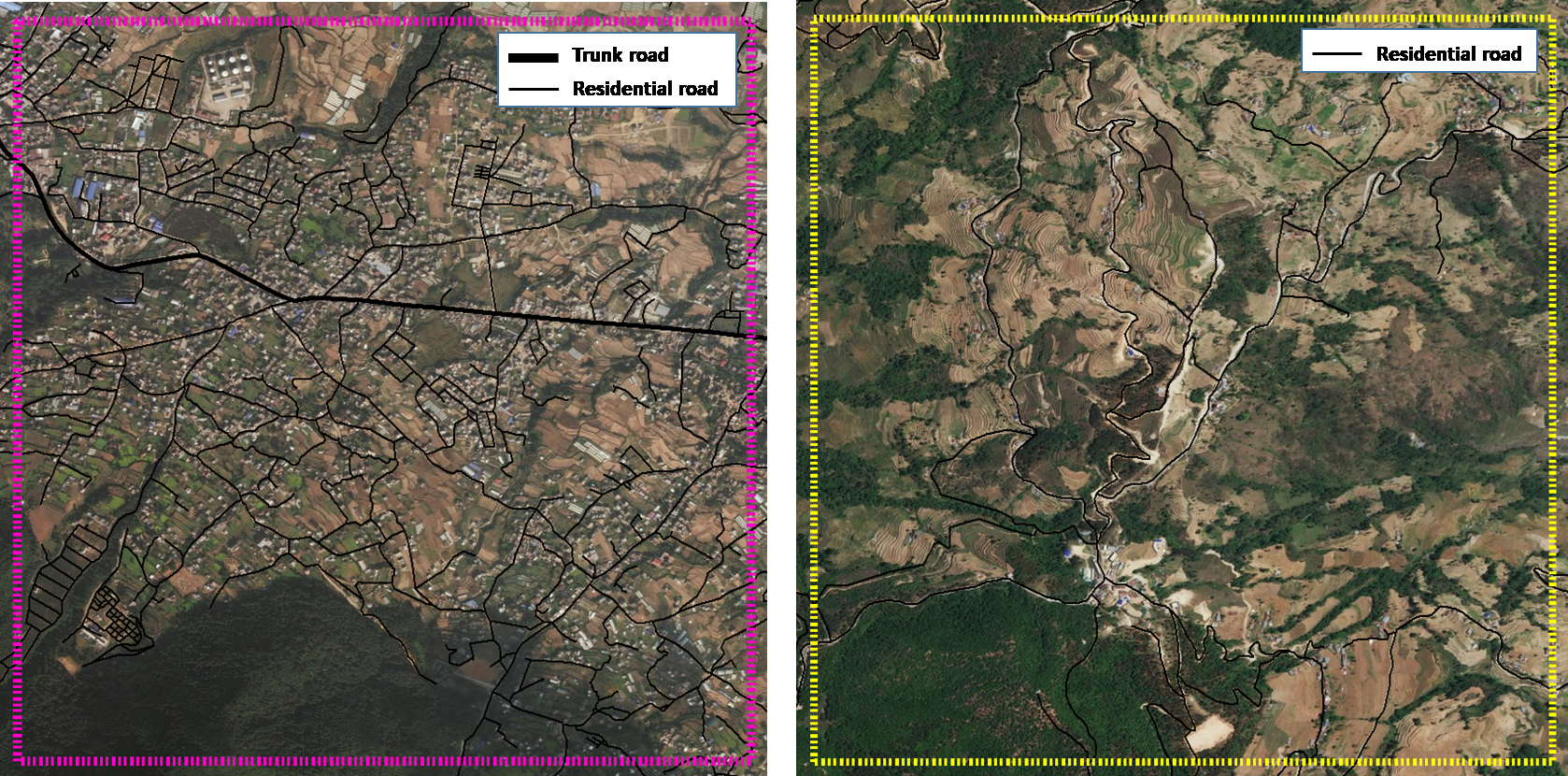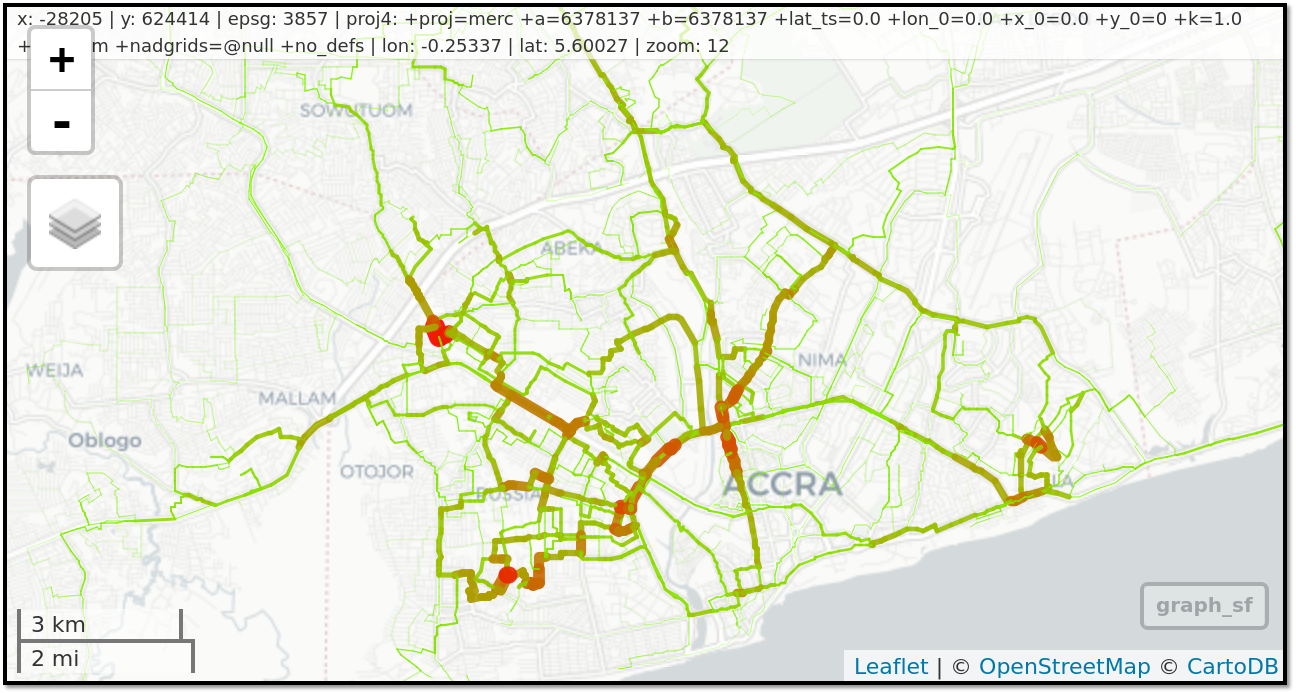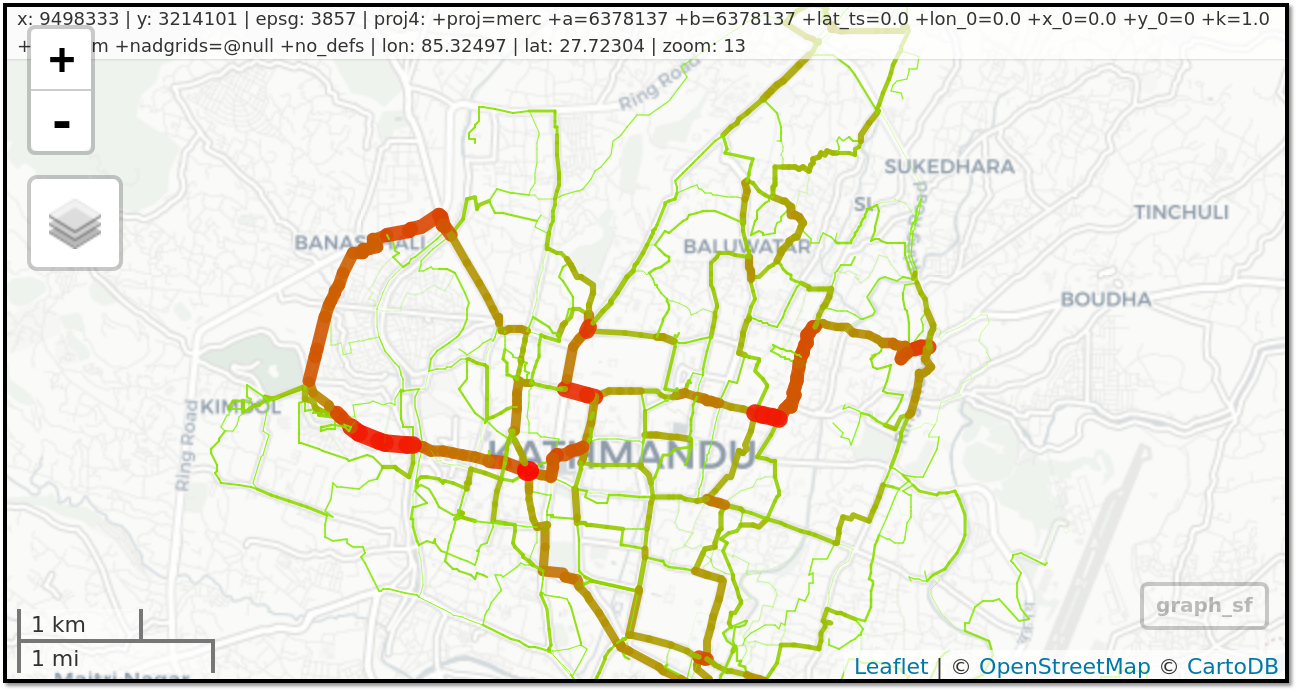Note: an interactive online version of this report can be found at https://bookdown.org/robinlovelace/who-active-travel-tool-feasibility/
For a pdf version of this report please see the releases page on the project's GitHub repo at github.com/ATFutures/who.
The benefits of active travel for individual and urban health, the environment, and society are becoming increasingly apparent (Celis-Morales et al. 2017), and many cities are preparing ambitious walking and cycling plans. However many transport authorities lack strong and actionable evidence to support this investment for a number of reasons, including:
- transport models have tended to focus on motor vehicles (Boyce and Williams 2015)
- data on active travel tends to be sparse and inaccessible (Kuzmyak et al. 2014)
- data and models are often not accessible for many potential stakeholders (e.g. civil society groups), or in formats that are difficult to understand and use (Naess et al. 2014)
This project aims to tackle these problems by assessing the feasibility of tools to provide actionable, publicly accessible, and geographically detailed evidence to prioritise investment in cycling for the case study cities of Accra, Ghana and Kathmandu, Nepal.
This document represents the results of a one-month-long project, which commenced on 18th December 2017, and which provides preliminary evidence for the feasibility of developing detailed models of how these cities might best adapt to encourage active transport.
Before diving into the case study cities and results of the feasibility study it is worth considering why it is important to map cycling potential at high geographic resolution on the route network. Rather than repeat the work done on the subject in excellent literature reviews (Aldred et al. 2017) or regression analyses at low geographical resolution (Mueller et al. 2018), we use a single case study to demonstrate the point. Seville (Spain) shows the tranformative effect of constructing a high quality cycling network which serves desire lines with high cycling potential.
Seville demonstrates how building appropriate infrastructure (protected cycle paths) in appropriate places (along key transport corridors, which can be identified with methods outlined later in this report) can lead to dramatic uptake of cycling. Despite high temperatures approaching those in Accra, cycling levels in the city quadrupled following investment in a carefully planned route network (illustrated in Figure @ref(fig:sevnet)). This network represents around 0.3 m of segregated cycle infrastructure per person (~200 km divided among the city's ~700,000 people) from less than 2% before 2006 to more than 8% (in the survey month of November) following infrastructure investment (Marqués et al. 2015).
The core cycling network in Seville (which has mean monthly summer temperatures of up to 28.2 °C), composed of the 'basic' (77 km) and 'complementary' (120 km) protected cylce path network (from Marqués et al. 2015). As described in that paper, this network led to the mode share of cycling in the city increasing fourfold, to now account for almost 10% of trips.
The case of Seville raises the question: how can investment in cycling be as effective as (or more so than) in Seville? The methods outlined in this report, and the tool it proposes, demonstrate how open access data and emerging open source software can be used to develop and guide a cycling strategy custom-tailored to a particular city in order to encourage similar transitions.
Two approaches were taken in parallel for this study: the collection and processing of open access data to gain an understanding of the feasibility of creating tools for active transport planning, and the analysis of secondary sources to ensure that any tools delivered in the case study cities are appropriate for local needs.
In terms of primary data, these were accessed from the following open access sources, all of which (except the third) are available worldwide:
- Transport network and building data from OpenStreetMap (OSM), an open access, freely available, crowd-sourced online mapping database (Barrington-Leigh and Millard-Ball 2017).
- Population density and some demographic data from worldpop (Tatem 2017)
- A 'benchmark' open access origin-destination dataset from the WICID census data portal for calibrating the route network model
The methods used to analyse the primary datasets involved a number of technical breakthroughs. These allow us to estimate cycling potential down to the road network level based on open data with, to our knowledge, unprecedented computational efficiency. This involved implementing a highly computationally efficient routing algorithm and, in a development that has arisen thanks to this project, new software for re-allocating the results of the routing algorithm back onto the road network. A custom level of road segmentation was developed to create this geographically aggregated flow map, which clearly shows routes with high cycling potential, as illustrated in Figure @ref(fig:seg) (see interactive version at rpubs.com/RobinLovelace):
Illustration of interactive map demonstrating the preliminary results: the routes in Accra with highest cycling potential.
In terms of secondary data we made use of the published academic literature, 'grey literature' on each of the case study cities, and reports and statistical data published by the local authorities. More conventional methods were used to assess these data sources and to make use of them to inform the feasibility of a tool for planning active transport futures in Accra and Kathmandu. We note that similar resources exist for other cities, although the transport policies of the case study cities seem to be particularly interesting and relatively well-documented for low-income nations.
The next two sections summarise each city in relation to active travel potential. These foundations provide important context for the results and discussion sections. Comparing the cities at the outset helps put the results in perspective and provides a foundation for a discussion of how a tool building on this work is likely to be useful to different stakeholders in each city.
Accra is the larger city, with a population approaching 5 million and a growth rate of around 3% per year in the Greater Accra Region according to the Ghana Statistical Service. Kathmandu has a population of just over 1.2 million, according to the World Population Review, with the larger Kathmandu region currently growing by over 4.5% per year.
The remainder of this section provides more depth on the transport contexts of each city which will inform the future development of tools for planning active travel futures. Illustrative photos of lack of cycling provision on the major roads in Accra and Kathmandu, and a typical example of a residential road in Bristol in which a cycling lane is provided, are shown in Figure @ref(fig:cyclists).
Figures illustrating cyclist in (a) Accra, (b) Kathmandu, (c) Bristol
The Greater Accra Metropolitan Area, simply referred to as Accra city, is the smallest geographical region of Ghana’s 10 administrative regions, covering only 1.4 percent of the total land area of Ghana (see Figure @ref(fig:AccraPopDen)). It is the second most populous region, after the Ashanti region. According to the Ghana Statistical Service, Accra city’s population is estimated to be approaching 5 million, with a growth rate of around 3% per year. Forty-three percent of the population is estimated to be between the age of 15 and 35 years (Ghana, Y.P.I., 2013).
GAMA contains 16 of the 216 local authority districts of the Republic of Ghana as shown in Figure @ref(fig:AccraPopDen). Administratively, the Accra Metropolitan local authority district serves as the capital of Accra city, and is administered by Accra Metropolitan Assembly, which is the political and administrative authority for the entire city of Accra.
Demography and population of Accra
The population of GAMA grew from 2,905,726 in 2000 to 4,010,054 in 2010 (Ghana Statistical Service, 2010). With a growth rate of 2.5% - below the current level of 3% - the population is estimated to increase to 5.9 million by 2040. The male and female population represents 49% and 51%, respectively. Based on the last population survey conducted in Ghana in 2010, the age distribution is given as follows: 0-14 years as 31%, 15-35 years as 43%, and 36 and above as 26%.
The region occupies a total land area of 3,245 km2, which makes it the geographically smallest region of the country. It has a population density of 1,236 people per km2, and is 90.5% urban with an annual urban growth rate of 3.1%, and recorded a positive net migration value of 1,275,425 in 2010 (Figure @ref(fig:AccraPopDen)). GAMA's labour force participation rate for its population aged 15 - 64 is estimated as 74.7%.
Accra population density (2013). Source: Thomas Brinkhoff: City Population,
Accra metropolitan district has the highest population density in GAMA, followed by the districts that are closest to it as shown in Figure @ref(fig:AccraPopDen).
Weather and Climate
The annual average temperature of Accra city is 27.6 °C, with mean monthly temperatures ranging from 25.9 °C in August (the coolest month) to 29.6 °C in March (the hottest). Relative humidity is high, ranging from 50% to 80%. Accra city, as with other southern cities, experiences two rainy seasons; April through June, and September through November. The harmattan is a dry desert wind that blows from the northeast from December to March. It lowers the humidity, bringing hot days and cool nights to northern parts of Ghana. This wind blows over the south in January.
These atmospheric conditions have implications for cycling uptake, making it potentially uncomfortably hot and sweaty in the hotter months. The impact of climate can be overestimated, however, as demonstrated by Seville in Spain which has a mean monthly temperature of 28.2 °C in summer, just 1.4 °C less than Accra.
Modal Split
Over a half (56%) of daily passengers in Accra are carried by buses, and a further 15% by taxi, with approximately 1 million passenger trips made each day in and out of the central area by both modes of transportation (Quarshie, 2007). Additionally, a recent study by the World Bank in 2010 on Accra residents' primary transportation mode choice to and from shopping and work also indicates that buses (tro-tros) are the most popular mode of motorised transport, accounting for 70 percent of public transport. This is followed by private cars (10%), and taxis (8%), with the Metro Mass Transit (MMT), quasi-private company buses, carrying the lowest proportion of 0.3%. The above studies emphasise the inefficiency of these vehicles in terms of the amount of road space used, congestion caused, and inconveniences caused to the passengers.
Issues with public transport
The public transport operators have been criticised for their disregard of operational standards and the safety of passengers, especially during late evening operation (Agyemang 2015). It has been found that the transport unions had not been able to regulate some of the behaviour of their members (Addo, 2002). For example, it is a common practice among the drivers to increase their fares, especially after heavy downpours, at peak-hour times, or after slight fuel hikes. There are no regulations in place by the union to combat some of these unacceptable practices (Agyemang, 2009; 2013). Similar practices have also been observed among taxi operators, who often charge double or triple the equivalent bus journey fare (Addo, 2002).
Making a case for cycling
Traffic congestion is a major transport problem in Accra city, with 70% of major roads operating at an unacceptable level of capacity at certain times of the day. It has been argued that moving from low capacity vehicles, such as buses and taxis, to a high-capacity, well-planned BRT system may help to reduce this traffic congestion (Quarshie, 2007). However, relieving congestion alone will not necessarily alleviate problems ensuing from vehicular emissions, and there will still be a pressing need for investment in non-motorised active transport systems, such as cycling and walking. In developing countries, such active transport systems are generally not recognised as key components of urban transport; and transport policies commonly fail to acknowledge let alone plan for this increasingly important mode of transportation.
Peoples’ attitudes towards cycling
A study conducted for the World Bank in 2010 estimated that only 1 to 4 percent of people in Accra city use a bicycle as their means of commuting within the city. However, according to an earlier study by the Centre for Cycling Expertise (CCE), the estimate was given as 9-10%. Although cycling is the predominant means of transportation in the northern (rural) parts of the country, it is generally not seen as an acceptable means of transport in the cities, such as Accra. An extensive study on bicycle use among the urban poor in Nima and Jamestown of Accra revealed the generally negative attitudes within certain communities toward cyclists (Turner and Kwakye 1996).
Many people do not think that cycling is safe in the present urban settings, such as Accra city. This seems largely due to the belief that the existing transport infrastructure lacks adequate support for active, non-motorised transport systems, such as cycling.
Government sponsored infrastructures
In a white paper prepared by the Ministry of Transportation in 2004, cycling was highlighted as a key component of the sustainable national transport policy. However, there has not been any real policy formulation regarding the incorporation of cycling within existing transport infrastructure, nor for promoting or encouraging cycling within the city. A further demonstration of the lack of enthusiasm for non-motorised transport options was revealed in the upgrade of the National Highway 1 (N1) motorway, which was completed in 2012. The project added more lanes to some of the sections of the N1 motorways, such as those connecting the neighbourhoods within Accra's functional boundaries. Along one expressway's 14 km stretch for example, there are only 1.6 km of segregated bicycle lanes, and only six bridges for cyclists and pedestrians to cross. This comparatively huge investment nevertheless resulted in cyclists being forced to share the road with the vehicles in most cases, thereby exacerbating the safety concerns that many people hold towards cycling.
In 2008, the department of Urban Roads, in collaboration with the CCE, developed the first ever Bicycle Masterplan (BMP) for Accra city. This is shown in Figure @ref(fig:ABMP) (Quarshie, 2007). A comprehensive study was also carried out in order to generate the technical details regarding the design, such as what type of bike facilities are required for a particular route ().
Accra bicycle masterplan (Quarshie, 2007)
The Federal Democratic Republic of Nepal consists of 7 provinces. Kathmandu District lies within Bagmati province, along with twelve other districts, which together occupy about 14% of the country. Kathmandu District consists of eleven municipalities, one of which is the municipality of Kathmandu Metropolitan City, the capital city.
For most statistical surveys and also for transport planning purposes, Kathmandu municipality is considered as part of a different geographical unit, namely Kathmandu Valley (KV). KV consists of five municipalities across three districts: two in Kathmandu District, one in Lalitpur, and two in Bhaktapur (Figure @ref(fig:katbound)). This mismatch between administrative authorities presents a notable difficulty in composing, financing, and implementing transportation (and other) plans for this region (East-West Center, 2009).
Boundaries of Kathmandu, Lalitpur and Bhaktapur Districts, their municipalities, and Kathmandu Valley. Source: East-West Center, 2009
While the elevation in Kathmandu District varies between 1,262 and 2,732 meters above sea level, Kathmandu itself is relatively flat and located at an average elevation of 1400 meters (Wikipedia, 2018a; 2018b). A report from February 2009 (East-West Center, 2009) classified the dominant land-use type in Kathmandu Metropolitan City as "Mixed" in the "Built up" category, covering nearly half the city (48.9%), followed by "Cultivation" (16.8%) and "Open area" (10.8%). Beyond those categories, a substantial part of the city is classified as Road (7.3%) or "Road median" (0.8%).
Demography and population of Kathmandu
According to the Nepalese Central Bureau of Statistics (CBS, 2001), Kathmandu is by far the most densely populated of all 75 districts, with 1,081,845 inhabitants (4.7% of the total Nepalese population) and a population density of 2,738.9 people/km2 in 2001 (Figure @ref(fig:katdens). The national average district density in 2001 was 157.3/km2 and the only other district, besides Kathmandu, to have a population density of over one thousand was Bhaktapur (1,895), which borders it to the east. The Kathmandu Valley is even more densely populated, at 4,400 p/km2, with a density of 19,250 p/km2 in Kathmandu municipality alone (World Bank, 2013). In September 2017 the population of Kathmandu Valley was estimated at approximately 3 million permanent residents, with an additional floating population of 2.5 million. Since Kathmandu has had an annual growth rate of 4.6% for at least the last decade (compared to 1.5% nationally), this means an increase of the population with 57% over this period of time. New municipalities in Kathmandu Valley even exhibit annual growth rates of 5.7% (Pradhan, 2017).
Kathmandu population density (2011). Source: Thomas Brinkhoff: City Population,
As Kathmandu Valley is the most urbanized region of Nepal, there is generally a good availability of utilities (water, gas, electricity), sanitation, education, and transportation, although recent rapid and haphazard urbanization has exacerbated conditions in the expanding areas, and has increased pressures on the existing infrastructure and facilities (East-West Center, 2009). In 2011 there were 1,329 people per kilometre of sewerage service in Kathmandu municipality, compared to the Nepalese average of 1,942. The roads in Kathmandu District were 68% black topped, 15% gravelled and 17% earthen in 2011. The district had 7,896 people per km of road at the time, with a total road length of 221 km, and a density of 56 km of road/km2, as opposed to 2,445 people/km and 7 km/km2 on average nationally. In Kathmandu Municipality nearly all roads were black topped in 2011 (99.7%), with the remainder being gravelled, and there were just over ten thousand people per kilometre of road (CBS, 2014).
Weather and climate in Kathmandu
Kathmandu District and Kathmandu Valley both span a great elevation range, and thus also cover multiple climate zones. The city itself lies in a warm temperate zone, with four seasons and average daily temperatures ranging from 10.8 °C in the coldest month (January; average minimum 2,4 °C, maximum 19.1 °C) to 24.3 °C in the warmest month (July; avg. min. 20.2 °C, max. 28.4 °C). Annual precipitation is 1,454.9 mm, with November being the driest month with an average monthly precipitation of 8.3 mm (1 precipitation day on average) and July the wettest with 363.4 mm (23 precipitation days). There is one monsoon season, which lasts from June through August, during which 64% of the annual precipitation falls over the course of 62 precipitation days. If September is included, 78% of the average annual precipitation is accounted for.
Kathmandu Valley public transport and modal split
In 2011 3.5 million trips were made each day on average in Kathmandu Valley. Walking was the dominant mode of transportation (40.7%), followed by bus (27.6%), motorcycle (26.0%) and car (4.2%). Bicycle trips comprised only 1.5%, although the equivalent figure two decades before had been 6.6%, prior to the advent of the rapid urbanization and motorization, whereas the motorcycle share had only been just over a third of the 2011 share in 1991 (9.3%). The share of trips made by public transport has remained broadly similar (27.2% in 1991). Walking had also decreased by 2011, down from its 1991 share of 53%. During the motorization period, pavements were removed from major roads in an attempt to create more space for motorized traffic, yet a 2011 study revealed that three of these roads still saw foot traffic at average rates of 690-2010 people per hour (maximum 816-2214/hr). Kathmandu was classed as "not walkable", and Kathmandu came out as one of the least walkable cities of Asia in a 2010 study. There are also no provisions for people with disabilities. In 2012 an average 270 cyclists per hour were found to be headed in each direction on Tundhikel Road during rush hour (9-11 a.m.) and 194 per hour during the rest of the day (CEN, 2013c; Khanal & Shrestha (CEN), 2012). Although motorcycles and cars together account for 93% of the vehicles in Kathmandu Valley, and public transportation buses for 3%, their travel mode share in 2011 was comparable. During the decade leading up to 2011, the annual rate of increase in newly registered vehicles greatly outpaced the population increase in Kathmandu Valley, at 14% more vehicles per year across all vehicles and 17% more motorcycles (CEN, 2013a).
Kathmandu Valley public transport operates between the hours of 04:30 and 21:00, with peak hours from 8:30 to 11:00, and from 17:00to 19:00. An attempt in 2012 to run public transport services until 23:00 with the help of armed police on each vehicle, was found to be financially intractable due to the low number of passengers and the high security costs. People requiring transportation for work-related purposes at night are commonly provided company transportation or taxi fares. Work or education represent the main purposes of transport in Kathmandu (40% of all trips by men, 36% by women). Other journeys are generally made between noon and 16:00. Most journeys last 15-30 minutes and only 10% last more than an hour. One third to one half of all travellers during peak travel times are female. 'Trip chaining', commonly because of child care or for shopping, is done by men and women in equal measures. The majority of people walk 5-10 minutes to reach a public transport service (46%) and a further 5-10 minutes (39%) to reach their final destination. Most passengers have to wait 5-10 minutes for an available vehicle at their origin and destination stops, both during morning peak hours (55%), during the evening peak (46%), and in transit (49% during morning peak hours, 48% in the evenings) (World Bank, 2013).
A 2012 public transport survey revealed the main purposes of public transport journeys in Kathmandu Valley to be work (39%) or study (34%). Nearly a third (32%) of all journey destinations were in the 'city core area', with just under a third (30%) of all transits also occurring in this area (Udas (CEN), 2012).
Men are more likely than women to have access to a family owned vehicle (including bicycles), and thus an alternative to public transport (men 26%, women 16%), though as of 2013 women have been rapidly acquiring small scooters. The primary determining factor influencing mode of transportation for both genders nevertheless remains journey duration (men 84%, women 74%; World Bank, 2013).
The forms of public transport in Kathmandu Valley
A wealth of different types of public transport vehicles have operated and are operating in Kathmandu Valley. All vehicles currently operating in the valley are privately owned and run by a syndicate, with exception of the Sahja buses which are operated by a cooperative. Most vehicles are individually owned and operated, although there are few individuals who own more than ten vehicles (World Bank, 2013).
The Nepal Transport Service initiated public transport in Kathmandu Valley in September 1959, eventually operating 11 buses between Kathmandu and Patan (in Lalitpur District, which borders Kathmandu municipality to the south). This system transported over ten thousand passengers each day during its prime, but shut down in 1966 (CEN, 2014a).
Meanwhile, Sahja Cooperative Yatayat was founded in 1961/62 to offer a means of affordable public transportation, not only in Kathmandu Valley, but across the entire country. While they operated a fleet of 200 Sahja buses (seating capacity of 55, or 100 including standing) in their peak days, they started to encounter financial difficulties from 1990 onwards due to government mismanagement and the private sector encroaching on the public transport sector. Consequently their services started to dwindle, until being suspended completely in 2006/07. After purchasing 16 buses, they resumed their Sahja bus services in Kathmandu Valley in 2012. The buses follow regular routes and the government set distance-based fare structure. To aid in route planning and fare calculation, the Monsoon Collective, in collaboration with students from Kathmandu University, have developed an open-source and freely accessible application (OpenStreetMap Wiki, 2014). Additionally there is a telephone number to enquire when the next bus will travel. The main reason people prefer modes of public transportation other than the Sahja buses is due to the bus's infrequent operation schedule (World Bank, 2013).
The electric trolley bus system, which had been a gift from the Chinese government, suffered a similar, but ultimately more decisive, fate. It ran from the centrally located Tripureshwor, through the valley for 13 km in an east-southeasterly direction towards Surya Binayak, from the end of 1975 until 1990, when it also started incurring losses due to mismanagement, amongst other causes. It suspended its services at the end of 2001, and when it reopened under Kathmandu Metropolitan City management in September 2013, it only operated on the 5 km stretch that fell within its municipal limits. After an additional year of suspended services, the system was officially terminated in November 2009. Plans to reinstate the trolley bus system have yet to materialise (Udas (CEN), 2012).
In 1993, USAID supported the introduction of seven Safa Tempos (electric three wheelers). In a further effort to control pollution, the government banned all diesel-operated three-wheelers in 1999/2000, resulting in the Safa Tempo fleet size increasing to the current capacity of 600 vehicles, as well as to the introduction of micro buses (CEN, 2014a). A Danida-funded project encouraged women to become Safa Tempo drivers, resulting in approximately 200 female drivers, with some being owners as well (World Bank, 2013). In addition to the Safa Tempos and the Sahja buses, minibuses and large buses also operate in Kathmandu Valley, resulting in a public transport fleet comprising over 5,321 vehicles, and servicing 222 routes in 2012/13 (CEN, 2014a). Additionally, there is a fleet of around seven thousand taxis, but very few people can afford to use them, and they will rarely use their meter, so their modal share is minimal, despite representing around 55% of all public transport vehicles (World Bank, 2013). The majority of passengers prefer to travel in the microbuses (49%), followed by buses and minibuses (40%), with only 10% expressing a preference for Safa Tempos. In general people prefer to travel in larger vehicles, due both to the greater likelihood of comfortable seats, and of increased travel speeds (Udas (CEN), 2012).
Transport-related air pollution in Kathmandu
Due to the bowl-shaped topography of Kathmandu Valley, emissions from vehicles and other sources can get trapped in the Valley for prolonged periods, especially during the winter months when atmospheric inversion occurs, and during the rest of the dry season. Combined with the aforementioned recent rapid rise in motorized transport in Kathmandu - 12% per year in the Bagmati zone (which encompasses the three Kathmandu Valley districts and five others) in the decade from 2002/03 to 2012/13 - this has led to 2-hourly PM10 levels recorded in the Putali Sadak area of Kathmandu during the winter of 2013/14 exceeding the national limits (NAAQS) by up to seven times, and exceeding recommended WHO limits by up to 15 times (CEN, 2014b).
Already in 2006, when there were far fewer vehicles in Kathmandu Valley, 63% of PM10 emissions were attributable to transportation, with vehicular emissions themselves accounting for 38%, and resuspended dust from unpaved and degraded roads for the remaining 25%. A more recent study from 2010 attributed 98% of PM~10 emissions to the transportation sector (CEN, 2014b).
Along with an increase in respiratory diseases, the increasing levels of air pollution have also led to a substantial increase in the number of deaths from chronic obstructive pulmonary disease in children (+24.2%) and across all ages (+15.9%) during the period 2005-2016, making it the second most prominent cause of death for the former and the fifth most prominent cause of premature death for the latter across all of Nepal (IHME, 2018).
Issues with public transport
The main issue with public transport in Kathmandu according to both men (80%) and women (70%) is "overcrowding", followed by "personal insecurity" (33% in women, 16% in men) and "reckless driving and fear of accidents" (18% in women, 16% in men). There are no great differences between men and women with regards to their perception of public transport, the main difference being in the feelings of personal insecurity while traveling, and experiencing physical difficulties while boarding or traveling, mainly due to the aforementioned overcrowding. Because of this, women are more likely to wait for the next vehicle. The second most commonly mentioned issue with public transport also relates to overcrowding, through increases in opportunities for pickpocketing, personal abuse or inappropriate touching (World Bank, 2013).
Women aged between 19 and 35 years, and especially those aged 19-25, are the most likely to list personal insecurity as an issue, with 43% of them mentioning it due to fearing or experiencing inappropriate touching. Men in the 19-25 age group on the other hand are among the least likely to list personal insecurity as in issue (just over 5%), together with those aged 65 or above. For both women and men of over 35, the fear of inappropriate touching is much less of an issue, though other personal insecurity concerns remain. While women feel most insecure while on vehicles, men mainly experience personal insecurity while boarding or disembarking. Of those for whom personal insecurity is an issue, it was revealed that 37% of women and 6% of men had actually experienced inappropriate touching during the preceding year. When taking the entire survey population into account, this figure was 26% for 19-35 year old women and 3.4% for men of all ages (World Bank, 2013). Both female (60%) and male (49%) passengers feel unsafe when traveling at night (Udas (CEN), 201).
Overcrowding is higher during evening than morning peak hours, partially due to fewer vehicles operating in the evenings. Safa Tempos will only accept an additional 2-3 passengers during peak hours, due to their dimensions not allowing for standing passengers unless hanging from the back. Micro buses can carry an additional 5-6 passengers during the morning and evening peak, and mini buses 10 to 13 (Figure @ref(fig:katcrowd)).
Peak hours vehicle type occupancy numbers in Kathmandu Valley (2010). Source: Tables 8 and 9 from Udas (CEN), 2012 (originally KSUT Project Report)
Nearly one in six people was concerned with transport fares, with some lower-waged workers having to allocate 20-40% of their wages to public transport costs. Many people have to relocate to save on commute costs. Since women have less access to personal vehicles, they tend to have to spend more on transport. Another concern beyond cost is the lack of consistent or transparent fare structure, in spite of the government-provided distance-based fare structure. The government actually adjusts fares according to such factors as fluctuations in petrol prices, yet since the rates are not signposted inside vehicles or elsewhere, people are at the mercy of what conductors deign to charge them (World Bank, 2013).
Many issues ensue from the public transport system being privately run by a syndicate system. Decisions on matters such as fare, routes, departure times, vehicle occupancy, or operational hours, are dictated by vehicle owners wanting to maximise their profits, resulting in overcrowding, long wait times due to operators not wanting to depart before vehicles are completely filled (usually far beyond their official capacity), or no services in the evenings when passenger numbers are relatively low. This syndicate structure also prevents any potential competitors from entering the market, although that could greatly benefit passengers (Udas (CEN), 2012).
While just over a third (35%) of passengers feel neither comfortable nor uncomfortable with the amount of seating space whilst traveling, a similar share (34%) feel uncomfortable and nearly two thirds (62%) of female passengers feel uncomfortable with the available space. A similar proportion of passengers (61%) feel that most drivers of public transport vehicles generally drive recklessly and 67% find the actual vehicles themselves unhygienic and not properly maintained. Furthermore, both drivers and passengers generally do not respect the actual locations of public transport stops, even though an overwhelming majority of passengers (84%) feel they should do. Most passengers find it easy (54%) or even very easy (11%) to identify public transport vehicles for their intended route, although some passengers struggle to do so, with 22% finding it difficult and 8% very difficult. A small portion (6%) found it initially difficult, yet subsequently managed to correctly identify them, generally once they have journeyed on that particular route for over a month (Udas (CEN), 2012).
Overall, the majority of passengers (58%) rate the experience of using public transport in Kathmandu Valley as "average", though a third (33%) find it "unpleasant" and only 10% of passengers rate it "pleasant" (Udas (CEN), 2012).
Government plans for alleviating congestion and pollution
While the government has already introduced some measures (banning diesel- and petrol-operated three wheelers, and introducing a green sticker system for vehicles in December 1999 (CEN, 2014b)), most focus to date has been on widening existing roads to 6 or 8 lanes, and on building more roads to accommodate increasing urbanization. Such measures have proven to be far from adequate in coping with the increased motorization, congestion and pollution, resulting in more sustainable and long-term plans being constructed. In July 2015 an introduction of the "Project on Urban Transport Improvement for Kathmandu Valley in Federal Democratic Republic of Nepal" was presented. This plan will involve the adoption of a radial-circumferential road system, allowing vehicles whose origins or destinations are not in the central business district to avoid having to pass through there (Government of Nepal, 2015). Figure @ref(fig:katplans) shows the proposed transport plan.
A hierarchical public transport route network will also be implemented, restricting the current number of routes to one-third based on passenger numbers, and creating four transfer terminals, one in each cardinal direction, to alleviate pressure on the central terminal. By reducing the import fees for vehicles with a seating capacity of over 40 seats, the plan aims to encourage a shift towards larger public transport vehicles. Furthermore, it envisions short-, mid- and long-term transport master plans to guide development during the subsequent 5, 10 and 15 years. These envision a number of different transport sectors, including non-motorized transport (Government of Nepal, 2015).
Kathmandu Sustainable Urban Transport Project plans. Left: Road network plans. Right: Public transport network plans. Scale: Outer ring road central E-W diameter approx. 4.5 km. Source: KSUTP, 2016
Making a case for cycling
According to a 2011 travel survey, journeys by private vehicle are 5 km long on average and 90% of non-motorized trips were completed in under half an hour (CEN, 2013c). These kinds of trips are eminently able to be supplanted by active, non-motorized forms of transport.
A number of organisations in Kathmandu and Nepal are committed to increasing the cycle mode share, whether to alleviate congestion, or to improve air quality and general road safety. On World Environment Day 2009, "Team for Nature and Wildlife" (TNW Nepal), a local NGO, launched a campaign to make Kathmandu a cycle-friendly city by 2020. In addition to lobbying for better cycling infrastructure and cycle training, they hope to convince especially those who currently use non-public motorized transport to switch to cycling. The Kathmandu Cycle City 2020 (KCC 2020) campaign is coordinated by "Cycle City Network Nepal" (CCNN), whose members are students of three Nepali Universities (two of which are located in Kathmandu District). In addition to the KCC 2020 campaign, CCNN also coordinates 4 other campaigns, namely Women on Wheels, Bike to School, Bike to Work, and Critical Mass.
"Clean Energy Nepal" (CEN) is an organisation which works on a "Clean Air & Urban Mobility" program, as well as two other programs reflecting their interest in sustainable transport. They hope both to raise awareness and to achieve required policy and behavioural changes. Clean Air Network Nepal (CANN) is part of the "Clean Air Asia" NGO, and has similar objectives. These two organisations, together with Cycle City Network Nepal, UN-Habitat, and Nepalese Youth for Climate Action, have initiated "A Campaign for People-centric Transport Systems", which is abbreviated as "MaYA" in Nepali.
While most children in Kathmandu Valley know how to cycle (77%), very few actually cycle to school, preferring instead to go on foot (>77%) or by school bus or public transportation (19%). The main reason for not cycling to school is negative perceptions of safety (41%), followed by not owning a bicycle (36%), pollution (13%), and distance (5%). Almost no respondents (<1%) claimed that cycling was unaffordable. Although they might not cycle to school, most children will cycle during general strikes, which also remove most vehicular traffic from the roads, while 26% will cycle at some time during a typical week, with 5% cycling every day. These figures clearly reveal a strong propensity to cycle, and suggest that providing a safer cycling infrastructure will encourage more students to cycle to school (CEN, 2013c).
During the 2013 "Cycling in Nepal: Challenges and Opportunities" workshop, participants vowed to make Kathmandu a cycle city by 2020, and have made a declaration to this effect, noting various points of action to be followed through with the relevant stakeholders. The second of these involves ensuring cycle lanes are included in any future developments in a connected and well considered manner (CEN, 2013b).
People's attitudes towards cycling
While cycling has historically been a popular mode of transportation in Kathmandu Valley, the aforementioned shift towards motorcycle transportation during the past decades decreased the cycling modal share to just 1.5% in 2011. Though nationally 30% of urban residents owned a bicycle in 2011, the equivalent figure in Kathmandu Valley was only 11%. This is partly due to a perception of cycling as a transportation mode for poor people, in addition to it being perceived as dangerous due to the lack of proper cycling infrastructures and unhealthy due to the high levels of air pollution. Pedestrians and cyclists are frequent casualties in road accidents, with 7 cyclist fatalities recorded in the fiscal year of 2011/12 out of a total of 180 involved in accidents that year, and 8 fatalities recorded for 2012/13 (CEN, 2013c). In general 130 major road accidents are reported in the valley each day, in addition to over a thousand minor incidents (World Bank, 2013).
Government sponsored infrastructures
The government of Kathmandu has proposed great plans for cycling infrastructure, yet it has taken a lot of pressure from Cycle City Network Nepal (CCNN) to get the Maitighar-Tinkune (both towards the southern boundary of Kathmandu Metropolitan City) cycle lane realised well over a decade after it was promised back in 2000 (CEN, 2013c). However, the Clean Air Network Nepal found this 2.7 km long cycle track to be rarely used, due to its serious deficiencies in signage, connectivity, surfacing, and safe passage at intersections and bridges, as well as the presence of obstructions (CEN & CANN, 2015). Most cyclist prefer instead to remain on the main vehicular carriageway. The 44 km of cycle tracks promised in 2005 as part of the 'Velo Mondial Charter and Action Plan for Bicycle Friendly Communities', and cycle lanes on roads wider than 22 meters, have yet to materialise. The first cycle track to be constructed runs from Tilganga to Sinamagal towards the easternmost boundary of the metropolitan city. This 1.2 km track benefits from being separated from the road and offers a lane for pedestrians as well, yet is again underused because of lacking signage, connectivity and the presence of obstructions (CEN, 2012). Figure @ref(fig:katcycle) compares the current cycling infrastructure in Kathmandu, including tracks that are under construction, with tracks designated as cycle lanes on the OpenStreetMap.
Left map: Planned road (brown), Underconstruction (red) and existing (green) cycle tracks as of December 2013. Source: CEN, 2013c, background Google Maps. Right map: OpenStreetMap Cycle Map and Google Aerial for Kathmandu Metropolitan City. Legend: Existing cycle tracks (blue) according to OSM. Source: openstreetmap.org.
The OpenStreetMap (OSM) data is constantly evolving and has recently reached a point where it is thought to cover 80% of the world's roads and demographic datasets, which are the basis for the feasibility study and a key source of information for a tool to plan active transport futures. The OSM network for Accra has 145,827 street segments connecting 131,349 distinct points, and extends over 4,072km, (Figure @ref(fig:xterOSM)). The OSM data also include 24,490 buildings, of which 23,102 include geometric descriptions only, while the remaining 1,388 buildings are divided between 28 distinct categories. The equivalent network for Kathmandu has 40,405 street segments connecting 37,770 distinct points, and extends over 539km (see Figure @ref(fig:xterOSM)). The OSM data also include 82,333 buildings of which 75,778 include geometric descriptions only, while the remaining 6,555 are divided between 344 distinct categories (in this case including many named buildings).
Characteristics of OSM route network data for case study cities.
The street network for Accra is more extensive, reflecting the greater spatial extent of the city, while data on buildings are considerable more detailed for Kathmandu than for Accra (see Figure @ref(fig:basicOSM)), primarily reflecting the engagement of the Kathmandu Living Labs (KLL) organisation, described below.
Basic OSM characteristics of case study cities
Demographic data for Accra from worldpop include population density estimates at 172,238 points, corresponding to estimates in roughly 30-by-30m grid cells. Estimates are available for total population density, as well as distributed between fourteen 5-year age classes from 0-5 years up to 60-65 years, and 65+ years. Demographic data for Kathmandu are not as detailed, and also do not include age classes. An overview map of Accra, the most extensively studied of our case study cities, is illustrated in the Figure @ref(fig:CyclingPotential).
Demographic data for Kathmandu are not as detailed, and also do not include age classes. By contrast Kathmandu has more detailed OSM data. An overview map of OSM data for Accra, the larger of the case study cities, is illustrated in the Figure below to provide an indication of OSM data in developing cities.
Overview of Accra road network (left) and initial results of cycling potential (right).
The street network datasets used for this project were downloaded from the OpenStreetMap (OSM), an open access, freely available, online mapping database (Barrington-Leigh and Millard-Ball, 2017). Generated through crowd-sourcing (Goodchild, 2007) by volunteers, the current database has grown to almost 50 gigabytes, and thousands of features are being added by the day. One uniqueness of OSM is that it allows its users the chance to contribute their local knowledge about places, thereby ensuring the features’ accuracy, completeness and thoroughness. Furthermore, a backend control/validation is implemented in order to ensure that the datasets conform with the Open Geospatial Consortium standards, which is the internationally recognised set of data standards for the global geospatial community.
For this project, we examined the quality of our OSM datasets and evaluate how well the datasets represent the reality on the ground. The quality of geospatial datasets can be evaluated using one, or a combination of metrics, such as positional accuracy, completeness, attribute accuracy and consistency (Haklay, 2010). The choice of any metrics often depends on the data requirements stipulated for a project, as well as the higher-quality baseline datasets available relating to the area in question. We chose OSM datasets for this project due to its relatively high positional accuracy with respect to the satellite basemap of the area, as well as its notion of continuous mapping, thereby leaning towards absolute completeness. Hence, we used ‘positional accuracy’ and ‘completeness’ metrics to evaluate the quality of our OSM datasets.
The positional accuracy is described as the position of a feature on a map relative to its actual position on the ground, while the completeness is an assessment of the amount of datasets that are missing on a map. For the baseline comparison datasets, we used the Bing areal imagery, which can be added as a background layer on OSM website, thereby allowing easy comparative analysis through visual inspection. The positional accuracy of the Bing areal imagery has been confirmed to be relatively better than that of Google Maps at nadir, with an RMSE of 7.9 as compared to 8.2 for the latter (Ubukawa, 2013). In the same study, the RMSE of OSM datasets was calculated to be 11.1m. Furthermore, the new Bing areal imageries for every country are usually released every three to four months in order to ensure the imagery is as current as possible.
This section provides an analysis of OSM quality in both case study cities compared with the 'benchmark' city of Bristol. Although Bristol is relatively well-mapped by international standards it should be noted that it was not chosen for the quality of its OSM data (which is surpassed by cities in Germany) but for its origin-destination data, which reveals a city with a diverse transport system and moderate but growing levels of cycling and walking.
Bristol is a city in South West England with a population density of 3,892/km2, according the the UK Office of National Statistics (2015), making the district one of the most densely populated district in the UK. Bristol's OSM network dataset is shown in the figure below; showing what could be considered ideal positional accuracy and completeness expected of an OSM dataset.
In order to inspect the dataset, we placed 2km by 2km grids at the geometrical centre of all the districts (Figure @ref(fig:osmbris), left), providing a good cross-section of the street network across Bristol. A careful visual inspection of each of the grid revealed very high positional accuracy and completeness of OSM network datasets.
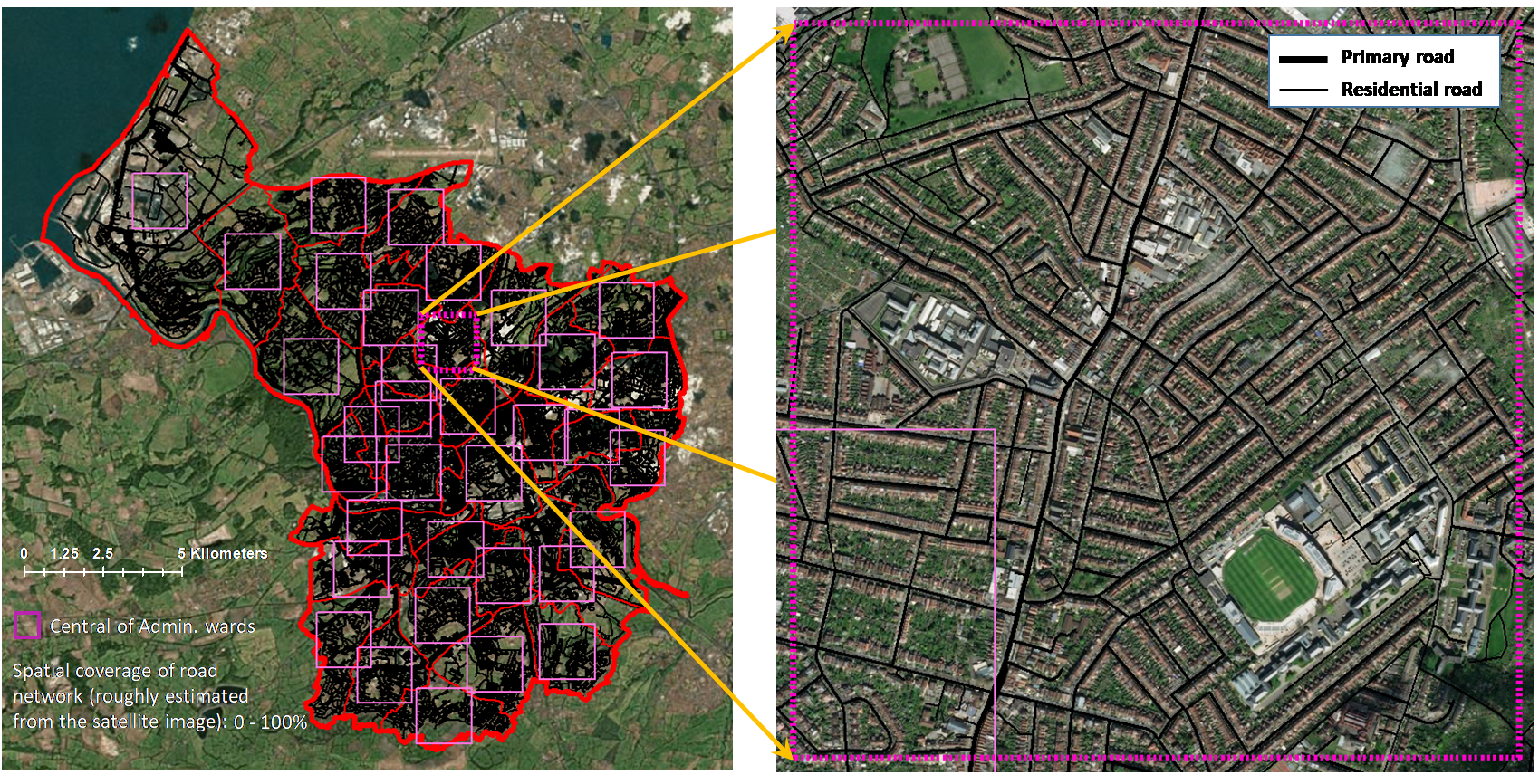
1. The OSM map of Bristol, with 2km x 2km grids placed at the centre of each administrative ward, and (b) the 2km x 2km grid at the centre of Bishopston administrative ward
Figure @ref(fig:osmbris) (right) is the 2km x 2km grid at the central of a randomly selected administrative ward - Bishopston. The figure shows perfectly aligned road segments along the central of their raster representation - indicating a very high positional accuracy. Furthermore, we could not find a single case of uncaptured road segment, indicating a hundred percent completeness. In order to inspect the positional accuracy and the completeness of both GAMA and Kathmandu, we used the same strategy of drawing 2km x 2km grids inside the administrative sub-division of each study area, and visually inspecting each of these grids.
In comparison with Bristol, GAMA is roughly thirty times bigger in size. Bristol is only about the same size as the Accra Metropolis, one of the 16 districts of GAMA. As a result of the relative size of GAMA as compared to Bristol, it is expected that more mapping efforts will be required to cover GAMA.
Figure @ref(fig:osmaccra) shows the distribution of the 2km x 2km grids drawn at the central of district sub-divisions of GAMA. The distibution of the grids also portrays a good cross-section of the street network across GAMA, from the high population density district of Accra metropolis in the south west, to the low population density of Shai Osudoku in the far east. We classified the districts into three, namely (1) urban (2) semi-urban and (3) rural districts. We based this classification on the spatial extent of the road network across each district, roughly estimated from the satellite image, through visual inspection. Thus, we have the districts whose network coverage have between 51-100%, 25-50%, and 0-25%, classified as urban, semi-urban and rural districts, respectively. In other words, we use road infrastructure as a proxy for city classification (Figure @ref(fig:osmaccra)).
Like many urban districts, two semi-urban districts, Ga West Municipal and Ga South Municipal districs, contain a very dense street network in areas that are adjacent to the urban district of Ga Central Municipal district. The four eastern-most districts, classified as 'rural', consist largely of trunk roads connecting GAMA to the other regions of the country.
The OSM map of GAMA, with 2km x 2km grids placed at the centre of each district.
The OSM datasets of GAMA revealed very high positional accuracy across all the districts. The positional accuracy is also uniform for all road classes. Though, many of the OSM road segments are not prefectly aligned at the central of the roads' raster representation, they are nevetheless contained within the widths of the roads.
There are variations in completeness level based on the three district categorisations, with urban districts having the best completeness level, followed by the semi-rural districts. Furthermore, it is observed that there are more OSM datasets in areas where roads are paved, than areas where roads are unpaved. This explains why roads in the urban districts are captured better than the roads in both the semi-urban and rural districts. Figure @ref(fig:osmaccrab) (a) and Figure @ref(fig:osmaccrab) (b) are the 2km x 2km grids at the centre of the Accra Metropolis and Ga West Municipal districts, an urban district and a semi-urban district, respectively. The oval shapes highlight examples of areas with missing OSM datasets. It can be observed that areas with missing OSM datasets are more prominent in semi-urban district than in the urban district.
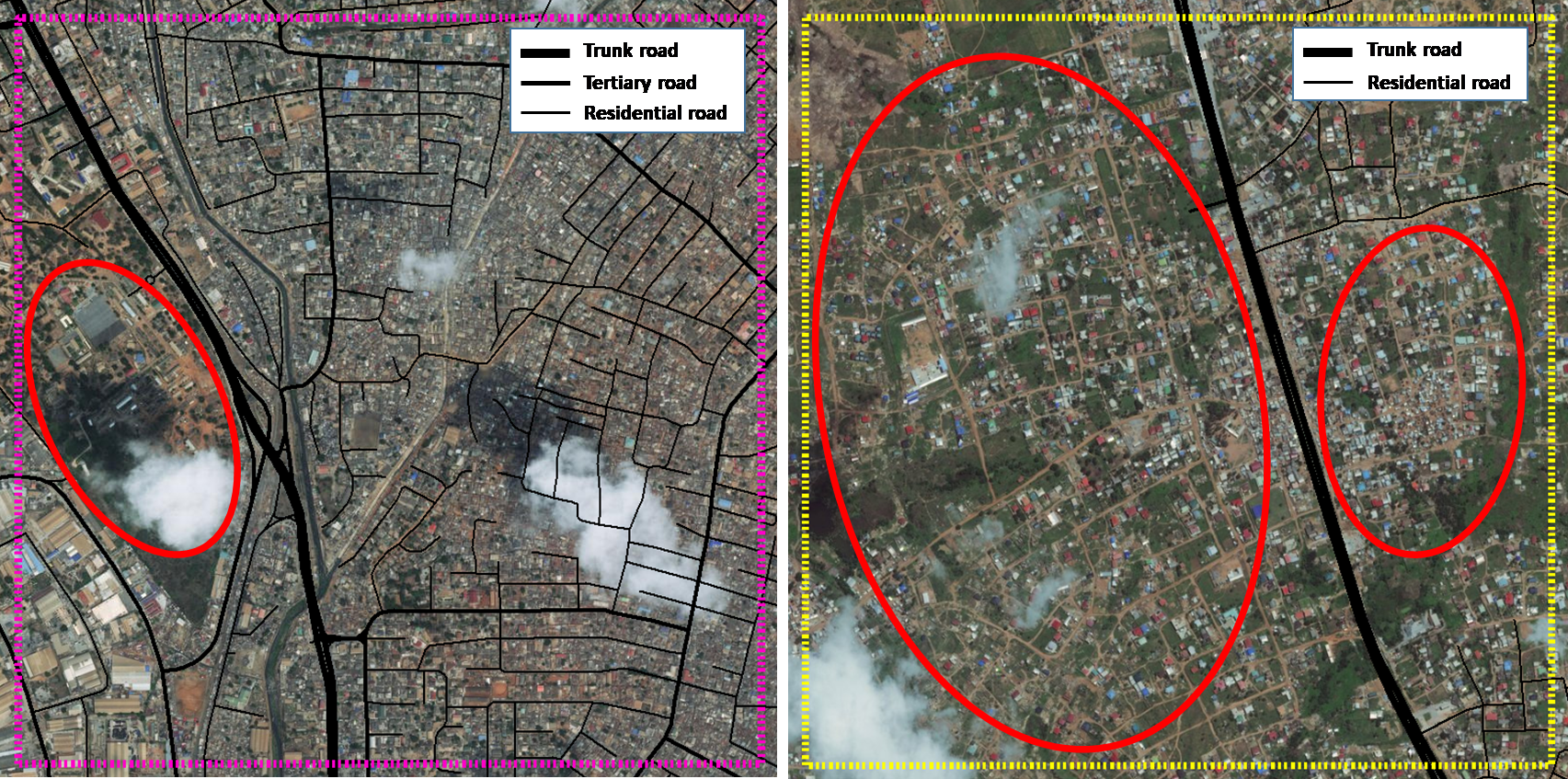
1. Accra Metropolis district - an urban district, and (b) Ga West Municipal district - a semi-urban district. The oval shapes indicate areas where streets are missing.
The "completeness" is also observed to vary by road class, from trunk roads (major road) having the highest completeness level, to the residential (unpaved) with the lowest completeness level. Even in the rural districts where the general completeness level is very poor, the trunk road class are the only well-captured roads.
In comparison with Bristol, Kathmandu is roughly four times bigger in size, but approximately eight times smaller than GAMA. While we expect that more mapping efforts will be required to cover Kathmandu as compared to Bristol, the former can still be covered relatively easier than GAMA.
Overall, Kathmandu is very well represented on OpenStreetMap, thanks to a number of projects by the Kathmandu Living Labs (KLL) organisation. KLL has not only informed residents about the importance of having accurate and freely available spatial data, and how these can help improve interactions between the local governing authorities and citizens, but also arranged training workshops to educate them in how to map their environments accurately, which by 2015 had been provided to over 1,400 people. In addition to this, they have had a specific project which involved mapping the 2,600 schools and 300 hospitals in the area in 2013. Their initiative has resulted in the mapping of 2,054,436 buildings and 135,063 kilometres of roads (KLL, 2018). A typical result of those efforts can be illustrated with Figure @ref(fig:compareKat) showing the Narayan Gopal Chowk area being mapped completely within a period of nine months.
Improved representation of Kathmandu on OpenStreetMap after KLL efforts. Zooming-in view of a typical intersection in Narayan Gopal Chowk area of Kathmandu. Source: KLL, 2018.
The same strategy of drawing 2km x 2km grids at the central of each administrative sub-division (here referred to as municipality) is employed. We also observed that the distibution of the grids provides a good cross-section of the street network across the whole area. Based on the spatial extent of the road network across each municipality, we classified the municipalities into two, namely: (1) urban and (2) semi-urban municipalities, with 51-100% and 0-50% network coverages, respectively.
The OSM map of Kathmandu, with 2km x 2km grids placed at the centre of each municipality.
The positional accuracy and the completeness of the Kathmandu OSM datasets is observed to be very similar to that of Bristol. In other words, in comparison with GAMA, the quality of OSM dataset of Kathmandu is better. For example, zooming into two randomly selected municipalities, BaadBhanjyang and Lapsephedi (Figure @ref(fig:osmkat)), representing an urban and a semi-urban municipality respectively, we found the positional accuracy of the OSM road network to be very similar to that of Bristol area. Also, we found every single road segment to have been properly captured, indicating a 100% completeness level.
To ensure that the results presented in this report are scalable we developed functions that are generalisable to other cities. The following functions were written to obtain population density and OSM data:
crop_worldpop_tifto access worlpop data for a specific cityget_osm_buildingsto get buildings dataget_streetnetto get the street network
These functions are in development and require further testing and documentation but we are confident they could form the basis of a 'back-end' of a larger international toolkit.
In addition to using Bristol as a baseline for assessing the relative accuracy and complement of the OSM datasets for Accra and Kathmandu, Bristol was also chosen as a reference city because of freely available origin-destination (OD) data which are needed to calibrate model parameters. Data for both study cities for this report consist of static population densities. This section describes how the dynamic OD data for Bristol were used to convert these static estimates into realistically calibrated estimates of flow densities throughout the street networks of the cities.
The preliminary results shown at the outset, and discussed further in the following sub-section, were generated by calibrating models to known behaviour of both pedestrians and cyclists in Bristol, U.K., using extensive existent behavioural data. This calibration procedure is proof-of-concept only, and relies on a single parameter which quantifies the decay in cycling propensity with distance. Data for the study cities (Accra and Kathmandu) are primarily population densities within single raster grid squares, while calibration data for Bristol were full origin--destination (OD) matrices quantifying densities or probabilities of trips between each population density grid point and all others. We developed a computationally efficient method to convert static population densities into estimates of dynamic flow between each grid point and all others, using a very well-established spatial interaction model dependent on a single parameter quantifying the extent to which 'interactions' -- in this context, flow densities -- decrease with increasing distance (Wilson 2008).
The calibration comprised the following three steps. First, the Bristol OD matrix was converted to total densities at all origin points by summing values for all destinations. These values are equivalent to the aggregate population densities obtained for the study cities. Second, an exponential spatial interaction model was applied to these densities to provide estimates of flows from each origin to each destination point, dependent on a single parameter quantifying the exponential decay in flow density with increasing distance. Finally, the calibration was performed by finding the value of the exponential decay parameter which best reproduced the observed OD matrix, with this procedure repeated separately for pedestrian and cyclist models.
The resultant decay coefficients for pedestrians and cyclists had respective values of 1.3 and 2.3km, indicating that 63% (1-exp(-1)) of all pedestrian trips are 1.3 km or less, while the same proportion of cycling trips are less than 2.3 km. Both of these models generated using the above procedure were very significantly related to the actual OD matrices, with the pedestrian model reproducing 46% of the structure of the observed OD matrix, and the cycling model reproducing 12%. (The comparably lower figure for the latter case is discussed further below.)
Using the methods described in the previous section, we ran the model to estimate cycling potential at the route network level for each city. To derive estimates of cycling we calibrated the model against data for Bristol. Note that Bristol is a city with moderate levels of cycling: 5%. If a different city were used to calibrate the model (recommended if cities are aiming for the kind of cycling uptake observed in Seville) the results would be different.
With this caveat in mind, these preliminary results aim at demonstrating the feasibility of methods to develop toolkits for investment in active travel. They are not aimed at providing a definitive 'core network' where investment should go (although they are an evidence based starting point). We hope to refine these estimates in future work, building on this feasibility study.
The results for Bristol are illustrated in Figure @ref(fig:calibbris). This demonstrates that the method creates a detailed route network that highlights the most important routes from a cycling perspective. The comparison with the results derived from a different method which was far more data-intensive and took much longer to generate (Lovelace et al. 2017) is encouraging, with arterial and orbital routes both prominent.
Estimated cycling potential on the route network in Bristol.
A notable difference between the two route networks illustrated in Figure @ref(fig:calibbris) is that our method tends to concentrate flows more along existing routes than the Propensity to Cycle Tool does. This is partly due to the weighting profiles used in our new method, which emphasise routes already conducive to cycling. The PCT, by contrast emphasises the fastest routes. Eploring the impact of different routing profiles is part of the plan for the next phase of this project. The results from these route network-level estimates of cycling potential can be found in the flows.Rds files in the who-data repo. See Section @ref(deliverables) for an overview of the deliverables.
The results for Accra are illustrated in Figure @ref(fig:calibaccra). This is the largest of the three cities and has the most estensive network with high cycling potential. It is interesting to note that, unlike Bristol, it has a 'polycentric' distribution of cycling potential, suggesting an extensive network will be needed for a cycling revolution in all parts of the city. Alternatively, it suggests that cycling investment should be prioritised in phases, with a an initial phase along route segments with highest potential, such as the are around Abossey Okai to the north-west of the ring road. The evidence would nevertheless need to be interpreted by local stakeholders before such concrete recommendations are made.
Estimated cycling potential on the route network in Accra.
The results for Kathmandu are illustrated in Figure @ref(fig:calibkat). This shows a more 'monocentric' city with high cycling potential on arterial routes north, east, south and west of the central area. Again the policy implications of this evidence depend on how many kilometres of protected infrastructure are on the table but suggest a city-wide network of the type illustrated in Figure @ref(fig:sevnet) would be appropriate if the investment for such an extensive network is available.
Estimated cycling potential on the route network in Kathmandu.
We have demonstrated a new method for estimating cycling potential down to the route-network that can scale to large cities such as Accra and can work in data-poor environments that lack access to origin-destination data. The results are promising. We have demonstrated that there are clear links between cycling potential and demographic variables, primarily population density. Contrary to the trend in wealthy cities for wealthy areas to have highest cycling potential, at least in terms of the 'near-market', the results presented in this report suggest that cycling potential is relatively evenly spread around developing-world cities and perhaps is higher around high-density but low income areas where average trip distances are low and people cannot afford cars.
This hypothesis would need to be verified against local empirical evidence, and there are strong reasons why cycling uptake is challenging among the poorest areas. Anecdotal evidence for Kathmandu (from Dr Helen Elsey who has spent time cycling in the city) suggests that, roughly speaking, two types of people cycle: wealthy people with enough confidence and high-quality bicycles to pedal through congested streets, and poor people who cannot afford alternative modes of transport but require wheels and efficiency for labour-intensive work. If this is true then the challenge is not only one of infrastructure but attitudes.
Protected and well-maintained cycling infrastructure is especially important in this context as it provides a safe space for less confident groups to venture out and signals that cycling is a legitimate mode of transport. The appropriate cycling network, and an appropriate mix of wider sustainable transport policies of which a cycling strategy should be a part, therefore depends on many factors beyond demographics and extant infrastructure. This means tools for transport planning should be linked-in to existing schemes and integrated with wider policies such as public health programs, equality and air pollution policies.
Our modelling software primarily consists of a custom-developed routing engine designed specifically for the task of routing very large numbers of origins to very large numbers of destinations, and for aggregating expected 'flows' along all segments of a network from such routing. The software is currently around 10 times more efficient that the industry-standard open-source routing library ('igraph'), and scales to far greater numbers of origins and destinations than does the Google routing API. (Performance of the latter can not be directly compared because timing depends on sending and receiving data; the Google API is also very expensive for large queries of the type needed in this context.)
One of the features we implemented for this preliminary report was the ability to allocate static population densities to sets of dynamic origins and destinations distributed according to a calibrated decay in relative numbers of trips with increasing distance. Not only is our implementation highly efficient, routing a test set of 1,000 origins to every single potential destination within the entire Accra network in around one minute, but to the best of our knowledge such highly scalable network allocation is simply not possible with any piece of existing transport planning software.
Although this present sub-section is intended to reflect the current state of our software, we note that the network allocation algorithm has been developed in order to be immediately extended to provide far more realistic allocations, through identifying different categories of typical destinations from OSM data (in terms of 'trip attractors' reflecting typical activities such as education, employment, leisure, or shopping), and developing different calibration models for each of these categories. The calibration model above reproduced only 12% of the actual variation in cycling behaviour in Bristol, yet presumed all cycling trips to reflect a generic purpose, with behaviour quantified by a single calibration parameter. A detailed application would involve fitting several distinct models for different categories of movement, and aggregating the results of each resultant flow layer across the network. Although categorical trip attractors were neither identified nor used in the present report, the software is already able to automatically extract such data directly from the OSM data base, directly enabling the construction of this series of categorical models as part of our subsequent work described below.
In summary, our open-source software is able to accept two primary, publicly available, global-scale data sets (OSM and worldpop), and convert these data to highly detailed and realistic estimates of likely densities of bicycle and pedestrian trips along every single segment of the entire street networks of both study cities. The configuration of the software as used in this preliminary study is in many ways proof-of-principle only, yet all components have been developed to accept more detailed locally available data, greatly increasing model accuracy.
The previous section reveals one of the clearest data needs to emerge from this preliminary report: detailed descriptions of transit behaviour separated into different categories of trips. These kinds of data are commonly aggregated as origin-destination matrices, yet may also be collated in terms of travel diary surveys, as in our more detailed calibration procedure to be implemented in subsequent phases as described below. Although our calibration procedure will yield a series of models reflecting distinct journey purposes, each of these will be calibrated to global data (described below), and will not be able to be guaranteed to reflect local behaviour. It would therefore be highly desirable to obtain some kind of local data reflecting differences in travel behaviour for different primary purposes.
This report has also revealed that the OSM data for Accra are not as rich as those available for Kathmandu, and it may be necessary to supplement current Accra OSM data with more detailed local data on the street network. Conversely, the population density data for Accra are far more detailed than those available for Kathmandu and, although this preliminary report has not examined the age-specific demographics of Accra, doing so will also enrich resultant models, and obtaining similarly detailed demographic data for Kathmandu would also enable a more direct comparison of model outputs. Importantly, such comparison is likely to be very mutually beneficial for both cities.
In autumn 2017 we developed a plan for the development of a toolkit for transport planning, an 'Active Travel Futures Toolkit' (ATFT). Based on the work documented in this report, we are confident that this work can yield great benefits to transport planning and health departments in cities internationally, and will both encourage and facilitate collaboration between them.
The feasibility study suggests that Accra and Kathmandu are appropriate cities for the development of such a toolkit: rather than directly aiming for an international toolkit, our experience with the PCT and subsequently with CyIPT suggests that intensive development focussed on specific case study cities where there is a well-defined policy question is an effective way to test and iterate online interactive tools. We therefore suggest we progress from the feasibility stage to the implementation stage for the two cities (and potentially others), with oversight from the WHO and engagement with local stakeholders. An outline of this plan is provided below, in 3 main phases:
-
Phase 1: Data collection, processing and characterisation of infrastructure
- Anticipated Duration: 3 months.
- Description: this stage will build on the work presented in this report but will incorporate new, locally provided datasets, with the aim of refining the methods and the resulting toolkits so that they are adaptive to local data.
- Deliverables: This phase will provide further data about each city, and will thereby provide essential input for the development of transport-planning toolkits which accurately reflect local conditions and behaviours.
-
Phase 2: Scenarios of cycling uptake
- Anticipated Duration: 3 months.
- Description: This phase will estimate current travel patterns and latent demand for cycling. The data collected from Phase 1 and documented in this report will be fed into refining the prototype spatial interaction and network analysis models, to estimate where people currently travel. In particular, the calibration model will also be refined as a series of models reflecting distinct journey purposes, each of which will yield its own calibration parameter. These calibrations will be developed using highly detailed time-use data from just under half a million (429,572) individuals from eight countries (Austria, Canada, Finland, France, the Netherlands, Spain, the U.K., and the U.S.A.). These time-use diaries include detailed information on modes of transport, journey times, and purposes. The pseudo-anonymized locations for each respondent will be used to extract the surrounding street network and associated categories of buildings and other structures from OSM in order to geo-locate local trip attractors. The combination of street network and travel time data will then be used to calibrate separate models for each distinct purpose. Model calibrations will also be enhanced where possible through the use of locally-provided data from the study cities obtained during Phase 1.
- Deliverables: This phase will deliver estimated spatial and temporal patterns of flow throughout down to the street network level, and representing both different categories of journeys and, for Accra, different age demographics. These outputs will be provided as geographic datasets, high resolution maps and reproducible scripts, enabling travel patterns to be updated in the future.
-
Phase 3: Extension to walking potential and health impact assessment of change
- Anticipated Duration: 6 months.
- Description: This will build on the analysis developed in Phase 2 to estimate to provide scenarios of change in both cycling and walking behaviour following specific interventions, building on our work on the Cycling Infrastructure Prioritisation Toolkit (CyIPT). This phase will also seek to estimate benefit-cost ratios (BCRs) of different options based on physical activity and behavioural change fed into health and health-economic models such as HEAT.
- Deliverables: This phase will ultimately result in the production of an Active Transport Future Toolkit (ATFT) for Accra and Kathmandu, with these toolkits providing a benchmark and role-model for other cities.
The source code underlying this project and data generated are available from the following repositories, which we hope to build on in future work:
- Code and prose: https://github.com/ATFutures/who
- Data: https://github.com/ATFutures/who-data
- Interactive map of route network in Accra: http://rpubs.com/RobinLovelace/341996
CBS. 2001. "Population Density."
CBS. 2014. "Environmental Statistics of Nepal - 2013." CNN Printing Press, Kathmandu, Nepal.
CEN. 2013a. "Sustainable Urban Mobility - Kathmandu Valley." Poster
CEN. 2013b. "Kathmandu Declaration 2013 for establishing Kathmandu as a Cycle City by 2020."
CEN. 2013c. "Cycling in Kathmandu Valley - Pedal power for Equity and Sustainability." MaYA Fact Sheet #3
CEN. 2014a. "Public Transportation in Kathmandu Valley - Restructuring and Reforming the System." MaYA Fact Sheet #4
CEN. 2014b. "Air Quality Status and Management in Kathmandu Valley - Make the City Air Breathable." MaYA Fact Sheet #5
CEN & CANN. 2015. "Assesment of Tinkune-Maitighar Cycle Track Design."
East-West Center. 2009. "Governance and Infrastructure Development Challenges in the Kathmandu Valley." Final Workshop Report, February 2009, Kathmandu, Nepal.
Government of Nepal. 2015. "The Project on Urban Transport Improvement for Kathmandu Valley in Federal Democratic Republic of Nepal - Introduction of the Project." July, 2015.
IHME (Institute for Health Metrics and Evaluation). 2018. "Nepal." Accessed January 2018.
Khanal, Prashanta & Shresta, Krity (CEN). 2012. "Walking and Cycling - A policy brief on non-motorized transport (NMT) system in Kathmandu Valley." Policy Brief #2, September 2012.
KLL (Kathmandu Living Labs). 2018. "Our Projects." Accessed January 2018.
KSUTP. 2016. "Kathmandu Sustainable Urban Transport Project (KSUTP) - A Sustainable Transport Project - Status and Progress." September 2016.
MFD (Meteorological Forecasting Division, Government of Nepal). 2018. "Kathmandu." Accessed January 2018.
OpenStreetMap Wiki. 2014. "Nepal/Yatayat." Last modified 12 January 2014; accessed January 2018.
Pradhan, Saroj Kumar (MPIT). 2017. "Initiatives of Multimodal Transportation Planning in Kathmandu Valley, Nepal." Multimodal Transportation Planning Best Practices and Integration of Transportation Technologies (Smart Cities) Workshop. September 13-15, 2017. Mumbai, India.
Udas, Suman (CEN). 2012. "Public Transport Quality Survey."
Wikipedia. 2018a. "Kathmandu." Accessed January 2018.
Wikipedia. 2018b. "Kathmandu District." Accessed January 2018.
WMO. 2018. "Kathmandu." Accessed January 2018.
World Bank. 2013. Gender and Public Transport: Kathmandu, Nepal. Nepal. © World Bank. License: CC BY 3.0 IGO.
Agyemang, Ernest. 2015. The Bus Rapid Transit System in the Greater Accra Metropolitan Area, Ghana: Looking Back to Look Forward. Vol. 69. doi:10.1080/00291951.2014.992808.
Aldred, Rachel, Bridget Elliott, James Woodcock, and Anna Goodman. 2017. “Cycling Provision Separated from Motor Traffic: A Systematic Review Exploring Whether Stated Preferences Vary by Gender and Age.” Transport Reviews 37 (1): 29–55. doi:10.1080/01441647.2016.1200156.
Barrington-Leigh, Christopher, and Adam Millard-Ball. 2017. “The World’s User-Generated Road Map Is More Than 80% Complete.” PLOS ONE 12 (8): e0180698. doi:10.1371/journal.pone.0180698.
Boyce, David E., and Huw C. W. L. Williams. 2015. Forecasting Urban Travel: Past, Present and Future. Edward Elgar Publishing.
Celis-Morales, Carlos A, Donald M Lyall, Paul Welsh, Jana Anderson, Lewis Steell, Yibing Guo, Reno Maldonado, et al. 2017. “Association Between Active Commuting and Incident Cardiovascular Disease, Cancer, and Mortality: Prospective Cohort Study.” BMJ, April, j1456. doi:10.1136/bmj.j1456.
Kuzmyak, J. Richard, Jerry Walters, Mark Bradley, and KM Kockelman. 2014. Estimating Bicycling and Walking for Planning and Project Development. Nchrp National Cooperative Highway Research Program Report 770. Washington, DC: Transportation Research Board of the National Academies.
Lovelace, Robin, Anna Goodman, Rachel Aldred, Nikolai Berkoff, Ali Abbas, and James Woodcock. 2017. “The Propensity to Cycle Tool: An Open Source Online System for Sustainable Transport Planning.” Journal of Transport and Land Use 10 (1). doi:10.5198/jtlu.2016.862.
Marqués, R., V. Hernández-Herrador, M. Calvo-Salazar, and J.A. García-Cebrián. 2015. “How Infrastructure Can Promote Cycling in Cities: Lessons from Seville.” Research in Transportation Economics 53 (November): 31–44. doi:10.1016/j.retrec.2015.10.017.
Mueller, Natalie, David Rojas-Rueda, Maëlle Salmon, David Martinez, Albert Ambros, Christian Brand, Audrey de Nazelle, et al. 2018. “Health Impact Assessment of Cycling Network Expansions in European Cities.” Preventive Medicine, January. doi:10.1016/j.ypmed.2017.12.011.
Naess, Petter, Jeppe Andersen, Morten Skou Nicolaisen, and Arvid Strand. 2014. “Transport Modelling in the Context of the ‘Predict and Provide’Paradigm.” European Journal of Transport and Infrastructure Research 14 (2): 102–21. http://vbn.aau.dk/ws/files/197640305/N_ss_et_al._2014_Transport_modelling_in_the_context_of_the_predict_and_provide_paradigm.pdf.
Tatem, Andrew J. 2017. “WorldPop, Open Data for Spatial Demography.” Scientific Data 4 (January): 170004. doi:10.1038/sdata.2017.4.
Turner, Jeff, and Edward Kwakye. 1996. “Transport and Survival Strategies in a Developing Economy: Case Evidence from Accra, Ghana.” Journal of Transport Geography 4 (3): 161–68. doi:10.1016/0966-6923(96)00019-1.
Wilson, Alan. 2008. “Boltzmann, Lotka and Volterra and Spatial Structural Evolution: An Integrated Methodology for Some Dynamical Systems.” Journal of the Royal Society Interface 5 (25): 865–71. doi:10.1098/rsif.2007.1288.
![The core cycling network in Seville (which has mean monthly summer temperatures of up to 28.2 °C), composed of the 'basic' (77 km) and 'complementary' (120 km) protected cylce path network [from @marques_how_2015]. As described in that paper, this network led to the mode share of cycling in the city increasing fourfold, to now account for almost 10% of trips.](https://raw.githubusercontent.com/ATFutures/who/master/fig/sevnet2.png)
